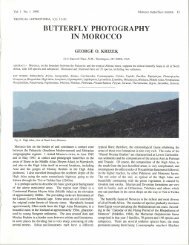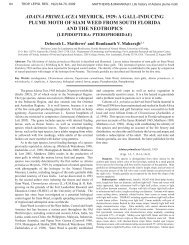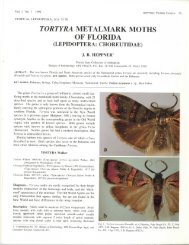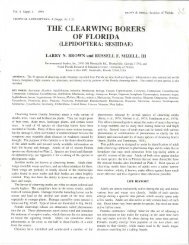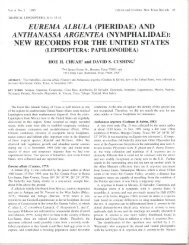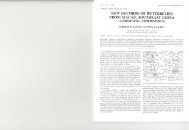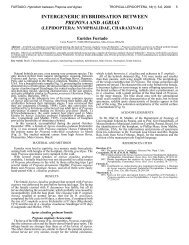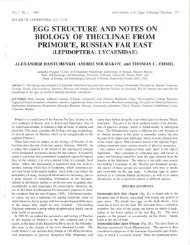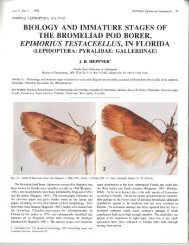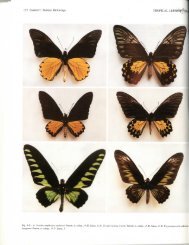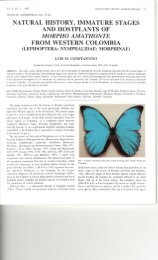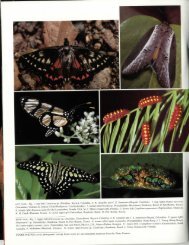taxonomic notes on ecuadorian adelpha, with the description of two ...
taxonomic notes on ecuadorian adelpha, with the description of two ...
taxonomic notes on ecuadorian adelpha, with the description of two ...
You also want an ePaper? Increase the reach of your titles
YUMPU automatically turns print PDFs into web optimized ePapers that Google loves.
Vol. 10 No. 1 1999 WILLMOTT and HALL: New Ecuadorian AdelphaTROPICAL LEPIDOPTERA, 10(1): 1-17TAXONOMIC NOTES ON ECUADORIAN ADELPHA,WITH THE DESCRIPTION OF TWO NEW SPECIES ANDSEVEN NEW SUBSPECIES(LEPIDOPTERA: NYMPHALIDAE: LIMENITIDINAE)KEITH R. WILLMOTT AND JASON P. W. HALLDept. <strong>of</strong> Entomology and Nematology, University <strong>of</strong> Florida, Gainesville, Florida 32611, USAABSTRACT.- Two new species and seven new subspecies <strong>of</strong> Adelpha Hiibner, [1819], are described from Ecuador (Adelpha attica hemileuca n. ssp., Adelpha hesterbergin. sp., Adelpha hyas hewits<strong>on</strong>i n. ssp., Adelpha iphicleola <strong>the</strong>ssalita n. ssp., Adelpha iphiclus estrecha n. ssp., Adelpha lamasi n. sp., Adelpha radiata aiellae n. ssp.,Adelpha radiata explicator n. ssp., Adelpha salus emmeli n. ssp.). The tax<strong>on</strong>omy and syn<strong>on</strong>ymy <strong>of</strong> Adelpha serpa (Boisduval, 1836) and related species, and Adelphaiphiclus (Linnaeus, 1758) and Adelpha iphicleola (H. W. Bates, 1864), are discussed and a number <strong>of</strong> <str<strong>on</strong>g>tax<strong>on</strong>omic</str<strong>on</strong>g> changes made.KEY WORDS: Adelpha attica hemileuca n. ssp., Adelpha hesterbergi n. sp., Adelpha hyas hewits<strong>on</strong>i n. ssp., Adelpha iphicleola <strong>the</strong>ssalita n. ssp., Adelpha iphiclusestrecha n. ssp., Adelpha lamasi n. sp., Adelpha radiata aiellae n. ssp., Adelpha radiata explicator n. ssp., Adelpha salus emmeli n. ssp., bait trapping, Bolivia, Brazil,Canal Z<strong>on</strong>e, Central America, Chocd, Colombia, Costa Rica, Ecuador, endemism, Mexico, mimicry, Neotropical, Panama, Paraguay, perching behavior, Peru, prem<strong>on</strong>tanerainforest, ridgetop, South America, tax<strong>on</strong>omy, Venezuela.The genus Adelpha c<strong>on</strong>tains some <strong>of</strong> <strong>the</strong> most comm<strong>on</strong> andc<strong>on</strong>spicuous species in <strong>the</strong> Neotropics, but also many that arelocalised and rare, and a number <strong>of</strong> taxa have remained undetecteduntil relatively recent intensive faunal surveys (Beutelspacher, 1975,1976; Steinhauser and Miller, 1977; DeVries and Chac6n, 1982;Orellana, 1996; Neild, 1996). In Ecuador to date, 56 species <strong>of</strong>Adelpha have been recorded out <strong>of</strong> a predicted total <strong>of</strong> 59,approximately <strong>two</strong> thirds <strong>of</strong> <strong>the</strong> genus and a number equalled <strong>on</strong>lyby Colombia. This great diversity <strong>of</strong> species, in combinati<strong>on</strong> <strong>with</strong> <strong>the</strong>country's range <strong>of</strong> habitats and <strong>the</strong> relative lack <strong>of</strong> historicalcollecting, has resulted in <strong>the</strong> discovery <strong>of</strong> a number <strong>of</strong> new Adelphataxa by <strong>the</strong> authors (see also Willmott and Hall, 1995). In particular,many <strong>of</strong> <strong>the</strong>se taxa inhabit <strong>the</strong> western slope <strong>of</strong> <strong>the</strong> Andes, an area<strong>of</strong> high butterfly species and subspecies endemism in both lowlandand middle elevati<strong>on</strong> habitats where a number <strong>of</strong> recent discoverieshave been made in o<strong>the</strong>r butterfly families (Willmott and Hall, 1994;Hall and Willmott, 1995, 1996, 1998; Hall, 1998). This paper formspart <strong>of</strong> a larger study by <strong>the</strong> first author to revise <strong>the</strong> systematics <strong>of</strong><strong>the</strong> genus Adelpha, in additi<strong>on</strong> to a l<strong>on</strong>g term research project byboth authors examining <strong>the</strong> diversity, ecology and biogeography <strong>of</strong><strong>the</strong> true butterflies (Papili<strong>on</strong>oidea) <strong>of</strong> Ecuador.Some <strong>of</strong> <strong>the</strong> historical c<strong>on</strong>fusi<strong>on</strong> between species in Adelpha hasarisen due to apparent mimicry between unrelated taxa (Aiello, 1984;Willmott, in prep.). In fact, although <strong>the</strong> genus exhibits a diversity <strong>of</strong>wing patterns, <strong>the</strong>se are all simple modificati<strong>on</strong>s <strong>of</strong> <strong>the</strong> generalAdelpha groundplan which can be readily recognised in all species.In order to facilitate comparis<strong>on</strong>s between taxa, we use a standardterminology for various elements <strong>of</strong> <strong>the</strong> wing pattern groundplan ineach descripti<strong>on</strong>, as illustrated in Figure 1. It should be noted thataccording to <strong>the</strong> studies <strong>of</strong> <strong>the</strong> evoluti<strong>on</strong> <strong>of</strong> butterfly wing patterns <strong>of</strong>Schwanwitsch (1924) and Nijhout (1991), <strong>the</strong> majority <strong>of</strong> <strong>the</strong> patternelements in Figure 1 actually represent <strong>the</strong> ground color <strong>of</strong> <strong>the</strong> wing,including <strong>the</strong> postdiscal band, and <strong>the</strong> postdiscal and submarginalseries. True "pattern elements" (sensu Schwanwitsch and Nijhout) are<strong>the</strong> dark areas between <strong>the</strong>se pale markings. However, it is muchclearer to discuss <strong>the</strong> ventral wing pattern differences betweenAdelpha taxa in terms <strong>of</strong> <strong>the</strong> shape, orientati<strong>on</strong> and expressi<strong>on</strong> <strong>of</strong><strong>the</strong>se pale areas <strong>of</strong> <strong>the</strong> wing, and we have <strong>the</strong>refore adopted analternative terminology which allows this.postdiscal band(upper, above M3)postcellular markingspostcellular barfourth cell barthird cell barsec<strong>on</strong>d cell barfirst cell barbasal streakbasal streakfirst cell barsec<strong>on</strong>d cell barthird cell barpostcellular barvenal stripeintervenal stripepostdiscal bandinner postdiscalseriesouter postdiscalseriesinner submarginalseriesouter submarginalseriespostdiscal band(lower, below M3)inner postdiscalseriesouter postdiscalinner submarginalseriesouter submarginalseriesFig. 1. A schematic drawing <strong>of</strong> <strong>the</strong> ventral wings <strong>of</strong> Adelpha aricia (Hewits<strong>on</strong>,1847), illustrating <strong>the</strong> terminology used in this paper for elements <strong>of</strong> <strong>the</strong> Adelphagroundplan.Most dorsal patterns are very simple and for <strong>the</strong> sake <strong>of</strong> clarity wedescribe <strong>the</strong>m using more widespread terminology. For example, werefer to an orange "subapical marking" <strong>on</strong> <strong>the</strong> forewing as opposedto <strong>the</strong> inner and outer postdiscal series, which is actually what thismarking represents. In all <strong>the</strong> species treated in this paper <strong>the</strong> innerand outer postdiscal series are not visibly separate <strong>on</strong> <strong>the</strong> ventralforewing in cells M[ and M2, and <strong>on</strong>ly sometimes in cell M3. We use<strong>the</strong> terms "c<strong>on</strong>cave" and "c<strong>on</strong>vex" <strong>with</strong> respect to <strong>the</strong> wing base.
2 WILLMOTT and HALL: New Ecuadorian Adetpha TROPICAL LEPIDOPTERAWhen describing subspecies in <str<strong>on</strong>g>tax<strong>on</strong>omic</str<strong>on</strong>g>ally difficult groups wegive a full descripti<strong>on</strong>, while for those whose affinities are obvious<strong>the</strong> descripti<strong>on</strong> is comparative. For <strong>the</strong> complex Adelpha serpa group,and Adelpha iphiclus and Adelpha iphicleola, which have historicallycaused much c<strong>on</strong>fusi<strong>on</strong> (e.g., Fruhstorfer, 1915; Hall, 1938;D'Abrera, 1987; DeVries, 1987), we present a more detailed<str<strong>on</strong>g>tax<strong>on</strong>omic</str<strong>on</strong>g> discussi<strong>on</strong> and syn<strong>on</strong>ymic checklists before <strong>the</strong>descripti<strong>on</strong>s. Nomenclature for wing venati<strong>on</strong> largely followsComstock and Needham (1918), except we refer to wing cells by <strong>the</strong>vein lying below or posterior to <strong>the</strong> cell, and genitalic terminologylargely follows Klots (1956), except that we refer to <strong>the</strong> projecti<strong>on</strong>from <strong>the</strong> basal, inner edge <strong>of</strong> <strong>the</strong> valva as <strong>the</strong> clunicula, afterFruhstorfer (1915).We use <strong>the</strong> following standard abbreviati<strong>on</strong>s in discussing<str<strong>on</strong>g>tax<strong>on</strong>omic</str<strong>on</strong>g> changes: n. syn. (a tax<strong>on</strong> which has been formerlyregarded as a valid species or subspecies, but here is regarded asinfrasubspecific); rev. stat. (a tax<strong>on</strong> which has most recently beenregarded as a valid species or subspecies or a syn<strong>on</strong>ym, here isrevised to a status which an earlier worker recognised); n. stat. (atax<strong>on</strong> whose rank has changed or is now regarded as a subspecies orsyn<strong>on</strong>ym <strong>of</strong> a different tax<strong>on</strong> to previous <str<strong>on</strong>g>tax<strong>on</strong>omic</str<strong>on</strong>g> combinati<strong>on</strong>s).It has been necessary to make three o<strong>the</strong>r <str<strong>on</strong>g>tax<strong>on</strong>omic</str<strong>on</strong>g> changes inthis paper in order to compare similar or related taxa, and we givean abbreviated discussi<strong>on</strong> for each. More extensive treatment will begiven in a forthcoming revisi<strong>on</strong> <strong>of</strong> <strong>the</strong> genus by <strong>the</strong> first author(Willmott, in prep.). Male genitalia are figured for all taxa, and <strong>the</strong>female genitalia for <strong>on</strong>e <strong>of</strong> <strong>the</strong> <strong>two</strong> new species, <strong>the</strong> female beingunknown in <strong>the</strong> sec<strong>on</strong>d. We have examined specimens orphotographs <strong>of</strong> virtually all Adelpha types known to be extant andc<strong>on</strong>sulted all original descripti<strong>on</strong>s <strong>of</strong> <strong>the</strong> known taxa; in <strong>the</strong> fewinstances where a type has not been located we base ouridentificati<strong>on</strong> <strong>on</strong> <strong>the</strong> original descripti<strong>on</strong>.The following collecti<strong>on</strong>s have been examined, <strong>the</strong> acr<strong>on</strong>yms <strong>of</strong>which are used throughout <strong>the</strong> text:AFEN Andrew F. E. Neild collecti<strong>on</strong>, Greenwich, L<strong>on</strong>d<strong>on</strong>, UKAME Allyn Museum <strong>of</strong> Entomology, Florida Museum <strong>of</strong> NaturalHistory, Sarasota, FL, USAAMNH American Museum <strong>of</strong> Natural History, New York, NY, USABMB Booth Museum, Bright<strong>on</strong>, UKBMNH Natural History Museum, L<strong>on</strong>d<strong>on</strong>, UK [(M)=Main,(R)=Rothschild, (T)=Type collecti<strong>on</strong>]DAT David A. Trembath collecti<strong>on</strong>, Surrey, UKEWSM Ernesto W. Schmidt-Mumm collecti<strong>on</strong>, Bogota^ ColombiaFSCA Florida State Collecti<strong>on</strong> <strong>of</strong> Arthropods, Divisi<strong>on</strong> <strong>of</strong> PlantIndustry, Gainesville, FL, USAJFL Jean F. LeCrom collecti<strong>on</strong>, Bogota, ColombiaKWJH Keith R. Willmott and Jas<strong>on</strong> P. W. Hall collecti<strong>on</strong>, Gainesville,FL, USALMC Luis M. C<strong>on</strong>stantino collecti<strong>on</strong>, Cali, ColombiaMCZ Museum <strong>of</strong> Comparative Zoology, Harvard University,Cambridge, MA, USAMJP Michael J. Perceval collecti<strong>on</strong>, Surrey, UKMNCN Museo Naci<strong>on</strong>al de Ciencias Naturales, Quito, EcuadorMNHN Museum Nati<strong>on</strong>al d'Histoire Naturelle, Paris, FranceMUSM Museo de Historia Natural, Universidad Naci<strong>on</strong>al Mayor de SanMarcos, Lima, PeruMHNUC Museo de Historia Natural Universidad de Caldas, Manizales,ColombiaSTRI Smiths<strong>on</strong>ian Tropical Research Institute, PanamaUSNM Nati<strong>on</strong>al Museum <strong>of</strong> Natural History, Smiths<strong>on</strong>ian Instituti<strong>on</strong>,Washingt<strong>on</strong>, DC, USAZMHU Zoologisches Museum, Humboldt Universitat, Berlin, GermanyAdelpha hesterbergi Willmott & Hall, new sp.Fig. 2a,b; 12a,bDescripti<strong>on</strong>.- MALE: forewing length 32.5mm; forewing distal marginslightly dentate, hindwing distal margin dentate, hindwings triangular andslightly produced at tornus. Dorsal surface: Forewing'. ground color darkbrown; four darker brown lines in discal cell, <strong>on</strong>e thick bar marking cellend and three basally, <strong>the</strong>se three also extending into cell 1A+2A;vertical, orange postdiscal band extending from anal margin to costa,slightly thinning from vein Cu2 to anal margin, widest in cell M3,narrowing from cell M2 to costa and slanting slightly basally, basal edge<strong>of</strong> band slightly c<strong>on</strong>cave, angled slightly towards costa at vein M3; threeorange subapical spots in cells M2, M, and R4, that in M, roughly twice<strong>the</strong> size <strong>of</strong> that in M2, a narrow dash in R4; fringe dark brown, whiteflecks at midpoint <strong>of</strong> cells M3-M, and R4. Hindwing: ground color darkbrown; three very faint darker brown lines in discal cell; white postdiscalband extending from costa towards anal margin near tornus, thickest incell M3 <strong>the</strong>n tapering to just extend into cell 1A+2A; three faint, darkerbrown bands distal <strong>of</strong> white band extending from costa to tornus, middleband terminating at tornus <strong>with</strong> <strong>two</strong> black basally pointing semicircularspots, lined basally <strong>with</strong> sparse orange-brown scaling and distally <strong>with</strong>a very thin silvery blue line; anal margin paler brown; fringe darkbrown, <strong>two</strong> white flecks in cell 1A+2A. Ventral surface: Forewing:ground color dark reddish brown; discal cell and postcellular barsblackish, first cell bar angled basally away from costa, sec<strong>on</strong>d straighter,third absent, fourth and postcellular straight, area between first andsec<strong>on</strong>d, and fourth and postcellular, reddish, remainder <strong>of</strong> discal cellsilvery gray except for broad reddish basal streak; silvery gray scalesdistal <strong>of</strong> postcellular bar in cell M3 and slight silvery gray scaling at base<strong>of</strong> cells 1A+2A and Cu2; bright, very pale cream postdiscal markingreflecting dorsal orange band, <strong>of</strong> similar shape except basal and distaledges indented slightly at veins, thick dark brown scaling dividingmarking (separating fused postdiscal series from postdiscal band) in cellM3, distal edge <strong>of</strong> marking in cells 1 A+2A-Cu, and M2-Mt dissolving indiffuse orange scaling; three subapical spots <strong>of</strong> same color as bandreflecting those <strong>on</strong> dorsal surface, representing fused postdiscal series;inner submarginal series composed <strong>of</strong> isolated silvery gray spots linedbasally <strong>with</strong> black, displaced basally in cells Cu2-M3 (most displaced inCU|), <strong>two</strong> in cell 1A+2A <strong>with</strong> anterior spot twice width <strong>of</strong> posterior spot,single spots in remaining cells, a large dash in Cu2, faint scales in Cu,,a larger semicircle in M3, an obl<strong>on</strong>g in M2 and M,; outer submarginalseries absent, except for a few scales in cells Cu2, M2 and in 1A+2A,where it exists as <strong>two</strong> silvery gray dashes; all veins lined indistinctly<strong>with</strong> paler orange-brown scaling <strong>with</strong>in and distal to <strong>the</strong> pale postdiscalmarking; distal margin blackish between each pair <strong>of</strong> veins in cellsCu2-Mp fringe black. Hindwing: ground color dark reddish brown indistal half, paler orange-brown in basal half; silvery gray band at base<strong>of</strong> wing extending to anal margin, filling most <strong>of</strong> area posterior to vein3A, except margin and vein 3A; silvery gray filling posterior half <strong>of</strong> cell3A from base to anal margin, anterior half orange-brown except for asilvery gray triangle bordering anal margin; postcellular and discal cellbars dark brown, area between first and sec<strong>on</strong>d, and third andpostcellular, pinkish, remainder <strong>of</strong> discal cell silvery gray (except basalstreak); first and sec<strong>on</strong>d bars c<strong>on</strong>tinue to vein Sc+R,, sec<strong>on</strong>d bordereddistally, and first basally, <strong>with</strong> a silvery gray bar, latter extending to fillarea between humeral vein and vein Sc+R,; silvery gray streak fillingbasal third <strong>of</strong> cell 1A+2A; postdiscal band extending and tapering fromnear costa (thin red-brown costal margin) to end roundly at vein 1A+2Anear tornus, pure white where coinciding <strong>with</strong> dorsal postdiscal band,grayish in cell 1A+2A and al<strong>on</strong>g distal edge <strong>of</strong> band to cell M,; innerpostdiscal series a very faint, poorly defined, pale reddish brown lineterminating in a small whitish triangle at vein 1A+2A; outer postdiscalseries similar to inner, but line segments between each pair <strong>of</strong> veinscrescent shaped and c<strong>on</strong>cave, each bordered distally <strong>with</strong> a dark brownbasally pointing semicircle; inner submarginal series composed <strong>of</strong>separate silvery gray, el<strong>on</strong>gate ovoid spots, <strong>two</strong> spots in cell 1A+2A
Vol. 10 No. 1 1999 WILLMOTT and HALL: New Ecuadorian Adelpha 37b8b3b10bFig. 2-10. Types <strong>of</strong> new taxa: a,c) dorsal surface; b,d) ventral surface. 2. Adelpha hesterbergi n. sp. holotype male. 3. A. lamasi n. sp. holotype male (a,b); allotypefemale (c,d). 4. A. salus emmeli n. ssp. holotype female. 5. A. attica hemileuca n. ssp. holotype male. 6. A. iphiclus estrecha n. ssp. holotype male. 7. A. iphicleolaihessalila n. ssp. holotype male. 8. A. hyas hewits<strong>on</strong>i n. ssp. holotype male. 9. A. radiata explicator n. ssp. holotype male. 10. A. radiata aiellae n. ssp. holotype male.
4 wiLLMOTT and HALL: New Ecuadorian Adelpha TROPICAL LEPIDOPTERAbordered basally by basally pointing black semicircles; outer submarginalseries composed <strong>of</strong> small silvery dashes, each bordered distally by black;fringe black, <strong>with</strong> <strong>two</strong> faint white dashes in cell 1A+2A. Head: eyes darkbrown <strong>with</strong> short setae in anterior half; dense white scales at ventral base<strong>of</strong> eyes; antennae black <strong>with</strong> white at ventral base and ventral surface <strong>of</strong>basal few segments; labial palpi white <strong>with</strong> broad black inner and outerlateral stripe and dorsal surface, latter also <strong>with</strong> l<strong>on</strong>g black hairs; top <strong>of</strong>head <strong>with</strong> chestnut brown scales, fr<strong>on</strong>s <strong>with</strong> brown hairs. Thorax: dorsalsurface black <strong>with</strong> short dark brown hairs, ventral surface grayish white,brown stripes where legs rest against thorax, legs white, mid andhindlegs <strong>with</strong> black dorsal surface. Abdomen: dorsal surface black <strong>with</strong>short dark brown hairs, ventral surface white, <strong>the</strong>n <strong>with</strong> dark gray lateralstripe, <strong>the</strong>n white lateral stripe, spiracles outlined <strong>with</strong> white. Genitalia(Fig. 12a,b): valvae <strong>with</strong> squared distal tip bearing numerous smallspines, clunicula l<strong>on</strong>g and pointed; saccus short compared to valvae.FEMALE: unknown.Types.- Holotype J: ECUADOR.- Carchi Prov.: nr. Lita, Rfo Baboso,ridge to east, 1050m, 17 Jul 1998 (K. R. Willmott) (to be deposited in<strong>the</strong> BMNH).Paratypes; 2
Vol. 10 No. 1 1999 WILLMOTT and HALL: New Ecuadorian Adelpha 5first cell bar and between sec<strong>on</strong>d and fourth cell bars silvery gray, areabetween first and sec<strong>on</strong>d, and fourth cell bar and postcellular bar,orange-brown, broad and indistinct orange-brown basal streak, triangularsilvery gray spot distal to postcellular bar in cell M3; triangular silverygray spot in cell 1A+2A at base <strong>of</strong> vein Cu2, some faint grayish scalingat base <strong>of</strong> cell Cu2; pale orange postdiscal marking reflecting dorsalorange band, c<strong>on</strong>sisting <strong>of</strong> postdiscal band and fused postdiscal series,spot in cell M3, almost divided in <strong>two</strong> by darker brown scaling, blackisharea basal to postdiscal marking in cell 1A+2A; all veins linedindistinctly <strong>with</strong> orange-brown, paler than ground color; five silvery graysubapical spots in cells M2, M, and R4, diffuse, paler orange bandc<strong>on</strong>tinues from anterior end <strong>of</strong> postdiscal marking between subapicalspots in cells M2 and M, (basal-most spots in cells M2 and M, bel<strong>on</strong>g t<strong>of</strong>used postdiscal series, distalmost spots bel<strong>on</strong>g to inner submargina]series, which is ei<strong>the</strong>r absent throughout remainder <strong>of</strong> wing or, at leastin some cells, fused <strong>with</strong> postdiscal band); diffuse paler orange-brownline, representing outer submarginal series, just basal <strong>of</strong> distal marginfrom apex to tornus; fringe black <strong>with</strong> faint white scales midwaybetween each pair <strong>of</strong> veins in cells M3-R4. Hindwing: ground color darkorange-brown; area basal to humeral vein entirely pale orange-brown; asilvery gray spot between humeral vein and vein Sc+R,; basal area <strong>of</strong>discal cell and area between first and sec<strong>on</strong>d cell bars, and third cell barand postcellular bar, pale orange-brown, remainder <strong>of</strong> discal cell (exceptbasal streak) silvery gray; first and sec<strong>on</strong>d discal cell bars c<strong>on</strong>tinueanterior <strong>of</strong> cell to vein Sc+R,, silvery gray basal to first cell bar and <strong>with</strong>a rough, silvery gray square distal to sec<strong>on</strong>d cell bar in cell Rs; basalarea <strong>of</strong> cells M2 and M, silvery gray; postdiscal band and innerpostdiscal series almost overlapping and forming a single pale silverygray postdiscal marking, which is brightest at costa and fades towardsanal margin, <strong>with</strong> slightly undulate basal and distal edges; outerpostdiscal series pale orange-brown, thinnest at costa and thickeningtowards anal margin to almost completely obliterate darker ground color;inner submarginal series <strong>of</strong> distinct silvery gray spots, brightest at costaand becoming fainter and more indistinct towards tornus, spots thickestin cells M2-M, and spot in cell M3 slightly displaced basally; outersubmarginal series pale orange-brown, diffuse and extending to margin;entire area between anal margin, posterior edge <strong>of</strong> discal cell and basaledge <strong>of</strong> postdiscal band pale orange-brown; fringe black <strong>with</strong> whitescaling between veins in cells Cu2-Rs. Head: eyes brown and covered<strong>with</strong> relatively l<strong>on</strong>g setae; labial palpi white, <strong>with</strong> broad black inner andouter lateral stripe, sparse, l<strong>on</strong>g black hairs ventrally and dense l<strong>on</strong>gblack hairs dorsally; antennae black, <strong>with</strong> white at ventral base and <strong>on</strong>ventral surface <strong>of</strong> basal few segments; top <strong>of</strong> head <strong>with</strong> chestnut brownscales, fr<strong>on</strong>s <strong>with</strong> brownish hairs. Thorax: dorsal surface black <strong>with</strong> l<strong>on</strong>gdark brown hairs, ventral surface pale grayish white except brown wherelegs rest against thorax, legs pale grayish white, mid and hindlegs <strong>with</strong>dark brown dorsal surface. Abdomen: dorsal surface black <strong>with</strong> l<strong>on</strong>g darkbrown hairs, ventral surface white, <strong>the</strong>n <strong>with</strong> dark gray lateral line, <strong>the</strong>nwhite lateral line, spiracles outlined <strong>with</strong> white scales. Genitalia (Fig.14a,b): valvae lacking distal spines, clunicula medium height, justprojecting above dorsal surface <strong>of</strong> valvae, rounded, saccus shortcompared to valvae.FEMALE; differs externally from male as follows: forewing length26mm; wings slightly broader; fringe <strong>with</strong> flecks <strong>of</strong> white <strong>on</strong>ly atmidpoint <strong>of</strong> cells 1A+2A-CU[ <strong>on</strong> forewing, and at midpoint <strong>of</strong> cell Cu,<strong>on</strong> hindwing. Genitalia and abdomen (Fig. 14c,d): corpus bursaerounded, lacking sclerotized bands, ductus bursae narrow and <strong>of</strong>approximately even width throughout, lamella postvaginalis weaklysclerotized; anterio-ventral comer <strong>of</strong> terminal tergite not more heavilysclerotized than remainder <strong>of</strong> tergite.Types.- Holotype 3: ECUADOR.- Carcki Prov.: nr. Lita, Ri'o Baboso,ridge to east, 1000m, 26 Aug 1996 (K. R. Willmott) (to be deposited in<strong>the</strong> BMNH).Allotype $: ECUADOR.- Esmeraldas Prov.: km. 15 Lita-Alto Tambo rd.,Anchayacu, 950m, 1 Jul 1998 (K. R. Willmott) (KWJH).Paratypes: ECUADOR.- 1 3: same data as HT (to be deposited in <strong>the</strong>USNM); 1 6: same data as AT (KWJH); Esmeraldas Prov.: 1 9: km. 16Lita-Alto Tambo rd., El Encanto, 800m, 1 Dec 1996 (K. R. Willmott) (tobe deposited in <strong>the</strong> AME); 1 9: km. 16 Lita-Alto Tambo rd., 850m, 19Jun 1994 (K. R. Willmott) (to be deposited in <strong>the</strong> MNCN). COLOMBIA.-Choco: 1 a: San Jose" del Palmar, 20 Jan 1991 (J. Salazar) (JFL); Valledel Cauca: 1 3: Queremal, km. 55, 1200m, 10 Apr 1990 (J. Salazar)(JFL); 1
6 WILLMOTT and HALL: New Ecuadorian Adetpha TROPICAL LEPIDOPTERAadditi<strong>on</strong> to <strong>the</strong> size <strong>of</strong> <strong>the</strong> dorsal forewing subapical spots, but thisvariati<strong>on</strong> occurs <strong>with</strong>in populati<strong>on</strong>s and is not geographical.Adelpha lamasi is currently known from very wet prem<strong>on</strong>tanerainforest habitats in a narrow elevati<strong>on</strong>al band from 900-1200mal<strong>on</strong>g <strong>the</strong> western slopes <strong>of</strong> <strong>the</strong> Andes, from <strong>the</strong> center <strong>of</strong> <strong>the</strong>Cordillera Occidental in Colombia to extreme northwestern Ecuador.All <strong>the</strong> males we have seen in nature have been attracted to trapsbaited <strong>with</strong> rotting fish in light gaps al<strong>on</strong>g ridgetops in slightlydisturbed primary forest. Females may be found in large light gapsor al<strong>on</strong>g trails through more disturbed habitats, where <strong>the</strong>re is anabundance <strong>of</strong> sec<strong>on</strong>dary growth near primary forest. The species canbe not uncomm<strong>on</strong> and its rarity in collecti<strong>on</strong>s probably reflects itslimited range. A. lamasi occurs sympatrically <strong>with</strong> several species<strong>with</strong> a similar dorsal wing pattern, such as A. rothschildi, A. lev<strong>on</strong>a,and (presumably) A. salus emmeli n. ssp. (see below). All arerestricted to similar elevati<strong>on</strong>al and geographic ranges, and <strong>the</strong> factthat <strong>the</strong>y do not form a m<strong>on</strong>ophyletic group <strong>with</strong>in <strong>the</strong> genus(Willmott, in prep.) suggests c<strong>on</strong>vergence <strong>on</strong> a similar dorsal wingpattern for some as yet unknown benefit (see Aiello, 1984).Adelpha salus emmeli Willmott & Hall, new ssp.Fig. 4a,bDescripti<strong>on</strong>.- FEMALE: forewing length 21mm; hindwing rounded,margin dentate. Dorsal surface: Forewing: ground color dark brown,three faint, darker lines in discal cell and a similar postcellular line;vertical, orange postdiscal band extending from vein 1A+2A to vein M2,basal edge slightly indented at each vein, band in cell 1A+2Aapproximately 1/3, and in cell Cu2 1/2, width <strong>of</strong> band in cells Cu, andM3, faint orange postdiscal scaling in cell M2; <strong>two</strong> large, orangesubapical spots in cells M2-MP squarish in M2, more triangular andbasally pointing in MM faint orange scaling anterior to latter spot in cellR4; fringe dark brown, white dashes at midpoint <strong>of</strong> cells 1A+2A-M,,entirely white in cells R5-R4. Hindwing: ground color dark brown, paleral<strong>on</strong>g anal margin; three faint, darker lines in discal cell and a similarpostcellular line; faint, pale grayish brown postdiscal band from costa tovein Cu2, followed distally by three faint, pale grayish brown lines fromcosta to anal margin, area between <strong>the</strong>se three bands darker brown;fringe dark brown, <strong>with</strong> white dashes at midpoint cells lA+2A-Rs.Ventral surface: Forewing: ground color orange-brown; discal cell barsdark brown, first cell bar curving basally away from costa, sec<strong>on</strong>d cellbar slightly c<strong>on</strong>cave, third cell bar absent, fourth cell bar slightly c<strong>on</strong>vex,postcellular bar faint, area between first and sec<strong>on</strong>d, and fourth andpostcellular, bars orange-brown, remainder <strong>of</strong> cell silvery gray except fordark brown basal streak; silvery gray triangle distal to postcellular barin cell M3, slight scaling in cell M2; slight silvery gray scaling in cell1A+2A at base <strong>of</strong> vein Cu2; very pale orange postdiscal markingreflecting dorsal orange band, except split into spots each surrounded byorange-brown scaling, and marking in cells Cu,-M3 split in <strong>two</strong> by avertical orange-brown line (separating postdiscal band from fusedpostdiscal series) which c<strong>on</strong>tinues al<strong>on</strong>g distal edge <strong>of</strong> postdiscal bandin cells 1A+2A and Cu2; a blackish area distal to this orange-brown linein cells 1A+2A and Cu2; three small silvery gray postdiscal spots in cellsM3-M[; <strong>two</strong> very pale orange subapical spots (fused postdiscal series) incells M2-M, reflecting dorsal subapical spots; inner submarginal seriesseparate silvery gray dashes, single in each cell except double in cell1A+2A, displaced basally in cells Cu, and M3; outer submarginal seriesabsent or replaced by orange-brown, except for single silver spot attornus; fringe black <strong>with</strong> slight white scaling between each pair <strong>of</strong> veins.Hindwing: ground color orange-brown; wing base entirely orange tohumeral vein; silvery gray band filling most <strong>of</strong> area posterior to vein 3Aextending to anal margin; silvery gray filling most <strong>of</strong> cell 3A from baseto anal margin, vein 3A broadly lined <strong>with</strong> orange-brown; postcellularbar absent, discal cell bars dark brown, area between first and sec<strong>on</strong>d,and third and discocellulars, orange-brown, remainder <strong>of</strong> discal cell(except basal streak) silvery gray; first and sec<strong>on</strong>d bars c<strong>on</strong>tinue to veinSc+R,, sec<strong>on</strong>d bordered distally, and first basally, <strong>with</strong> a silvery graybar, latter extending to fill area between humeral vein and Sc+R,; silverygray streak filling basal third <strong>of</strong> cell 1A+2A; silvery gray postdiscal bandextending from near costa to end roundly at vein 1A+2A near tomus,basal and distal edges uneven; inner and outer postdiscal series joined incell Rs forming a single, squarish silvery gray spot, separatingsubsequently, inner composed <strong>of</strong> a similar spot in cell M, <strong>the</strong>n muchreduced to a few silvery gray scales in remaining cells and extending tocell 1A+2A, outer an orange-brown line, area between <strong>two</strong> series darkbrown; inner submarginal series composed <strong>of</strong> isolated silvery gray, thickdashes, bordered basally by dark brown; outer submarginal seriesorange-brown; fringe black, some white scaling between each pair <strong>of</strong>veins. Head: eyes brown and covered <strong>with</strong> relatively l<strong>on</strong>g setae; labialpalpi white <strong>with</strong> broad black inner and outer lateral stripe, sparse, l<strong>on</strong>gblack hairs ventrally and dense l<strong>on</strong>g black hairs dorsally; antennae black,<strong>with</strong> white at ventral base and <strong>on</strong> ventral surface <strong>of</strong> basal few segments;top <strong>of</strong> head <strong>with</strong> chestnut brown scales, fr<strong>on</strong>s <strong>with</strong> grayish brown hairs.Thorax: dorsal surface dark brown <strong>with</strong> l<strong>on</strong>g dark brown hairs, ventralsurface pale grayish white except brown where legs lie against thorax,legs pale grayish white, mid and hindlegs <strong>with</strong> dark brown dorsalsurface. Abdomen: dorsal surface black <strong>with</strong> l<strong>on</strong>g dark brown hairs,ventral surface white, <strong>the</strong>n <strong>with</strong> dark gray lateral line, <strong>the</strong>n white lateralline, spiracles outlined <strong>with</strong> white scales. Genitalia and abdomen: corpusbursae rounded, lacking sclerotized bands, ductus bursae narrow and <strong>of</strong>approximately even width throughout, lamella postvaginalis weaklysclerotised; anterio-ventral corner <strong>of</strong> terminal tergite not more heavilysclerotized than remainder <strong>of</strong> tergite.MALE: unknown.Types.- Holotype ?: ECUADOR.- Pichincha Prov.: km 85 Old Sto.Domingo rd., 1 Jul 1980 (T. C. Emmel) (FSCA).Etymology.- This distinctive subspecies is named for its discoverer,Thomas Emmel, in recogniti<strong>on</strong> <strong>of</strong> his lifetime's study <strong>of</strong> butterflies andin gratitude for all his help and encouragement during <strong>the</strong> course <strong>of</strong> ourresearch.Diagnosis.- Adelpha salus emmeli n. ssp. differs from <strong>the</strong> nominate inhaving a vertical, instead <strong>of</strong> diag<strong>on</strong>al, orange dorsal forewing band,which does not extend to <strong>the</strong> costa (in <strong>the</strong> nominate it is as broad at <strong>the</strong>costa as it is in cell Cu2). A fur<strong>the</strong>r undescribed subspecies was figuredby Hall and Willmott (1993) (as Adelpha nr. boreas} which also has adiag<strong>on</strong>al forewing band as in <strong>the</strong> nominate. A, salus emmeli is verysimilar to Adelpha lev<strong>on</strong>a and Adelpha rothschildi, but both <strong>of</strong> thosespecies have <strong>the</strong> postdiscal band and postdiscal series fused <strong>on</strong> <strong>the</strong>ventral surface <strong>of</strong> <strong>the</strong> forewing in cells Cu, and M3 (i.e. <strong>the</strong>re is no darkline splitting <strong>the</strong> pale postdiscal marking in cells Cu, and M3).Discussi<strong>on</strong>.- Although this new subspecies differs <strong>on</strong> <strong>the</strong> dorsalsurface significantly from <strong>the</strong> nominate, <strong>the</strong> ventral hindwing pattern,especially <strong>the</strong> fusi<strong>on</strong> <strong>of</strong> <strong>the</strong> inner and outer postdiscal series at <strong>the</strong>costa and <strong>the</strong>ir c<strong>on</strong>figurati<strong>on</strong> over <strong>the</strong> remainder <strong>of</strong> <strong>the</strong> wing, isidentical in all o<strong>the</strong>r specimens <strong>of</strong> A. salus we have examined anddiagnostic <strong>of</strong> this species. In additi<strong>on</strong>, <strong>the</strong> holotype lacks sclerotizedbands <strong>on</strong> <strong>the</strong> corpus bursae <strong>of</strong> <strong>the</strong> female genitalia, similar tospecimens <strong>of</strong> Central American A. salus.Adelpha salus is a very rare and poorly known species, which wasunknown to Fruhstorfer (1915), subsequently figured by Hall (1935)in his original descripti<strong>on</strong>, but omitted by D'Abrera (1987) due to <strong>the</strong>absence <strong>of</strong> specimens in <strong>the</strong> BMNH. We have seen just 19 specimensin collecti<strong>on</strong>s, distributed from Mexico to western Ecuador; anundescribed subspecies represented by specimens in severalcollecti<strong>on</strong>s occurs from Mexico to Panama, <strong>the</strong> nominate is knownfrom a handful <strong>of</strong> sites around <strong>the</strong> nor<strong>the</strong>rn tips <strong>of</strong> <strong>the</strong> CordillerasOccidental and Central in Colombia, while <strong>the</strong> new subspeciesdescribed here is known <strong>on</strong>ly from <strong>the</strong> holotype female from centralwestern Ecuador, although based <strong>on</strong> <strong>the</strong> ranges <strong>of</strong> o<strong>the</strong>r sympatricAdelpha taxa its range is certain to extend into sou<strong>the</strong>rn Colombia.The type locality lies at around 1200m <strong>on</strong> <strong>the</strong> western slopes <strong>of</strong> <strong>the</strong>
Vol. 10 No. 1 1999 WILLMOTT and HALL: New Ecuadorian Adelpha 1Ecuadorian Andes, in prem<strong>on</strong>tane rainforest, while <strong>the</strong> nominatesubspecies is known from 800m to 1500m, <strong>with</strong> <strong>on</strong>e doubtful record<strong>of</strong> 2000m. Although <strong>on</strong>ly a single specimen <strong>of</strong> A. salus emmeli isknown to us, il differs <strong>on</strong> <strong>the</strong> dorsal surface so substantially from <strong>the</strong>nominate, which is o<strong>the</strong>rwise c<strong>on</strong>stant in all <strong>the</strong> specimens we haveseen, that we feel it merits descripti<strong>on</strong>. The close resemblance <strong>of</strong> <strong>the</strong>dorsal surface to o<strong>the</strong>r, relatively unrelated, species <strong>of</strong> Adelpha,which are endemic to a similar elevati<strong>on</strong>al range in <strong>the</strong> westernAndes, such as A. lev<strong>on</strong>a, A. rothschildi and A. lamasi n. sp. (seeabove), suggests some mimetic relati<strong>on</strong>ship between <strong>the</strong>se taxa.Adelpha attica hemileuca Willmott & Hall, new ssp.Fig. 5a,b; 15a,bDescripti<strong>on</strong>.- MALE: forewing length 24.5mm; wings <strong>of</strong> similar shapeto nominate subspecies. Differs from <strong>the</strong> nominate subspecies as follows:Dorsal surface: Forewing: orange postdiscal band slightly darker andbroader, <strong>with</strong> less <strong>of</strong> a "notch" at basal edge at vein M3, band is thickerat costa, subapical spots reduced. Hindwing: postdiscal band entirelyorange from costa to vein M2, c<strong>on</strong>stricted so as almost broken at veinM2, and tapering to a point in cell 1A+2A. Ventral surface: Forewing:postdiscal band obscured throughout by sparse orange scales; faintsilvery gray dashes <strong>of</strong> inner submarginal series in cell Cu,. Hindwing:darker, slightly purplish brown ground color; inner postdiscal series abetter defined, faint pale grayish line. Head, Thorax, Abdomen, andGenitalia (Fig. 15a,b) as in nominate subspecies.FEMALE: unknown.Types.- Holotype
8 WILLMOTT and HALL: New Ecuadorian Adelpha TROPICAL LEPIDOPTERAin all specimens from Mexico to <strong>the</strong> Amaz<strong>on</strong>, <strong>on</strong>ly changing in <strong>the</strong>south east Brazilian A, iphiclus ephesa (Mene"tries, 1857), whichFruhstorfer (1915) also regarded as a subspecies <strong>of</strong> A. iphiclus. Inthis populati<strong>on</strong> <strong>the</strong> orange subapical marking <strong>on</strong> <strong>the</strong> forewing extendsinto cell M3 and broadly borders vein M3, but <strong>the</strong>re are severalventral characters (see below) shared <strong>with</strong> A. iphiclus iphiclus, inadditi<strong>on</strong> to specimens <strong>of</strong> A. iphiclus from Paraguay and Brazil <strong>with</strong>subapical markings intermediate between typical iphiclus and ephesa.In northwestern South America A. iphiclus appears to exhibit muchphenotypic variati<strong>on</strong> in <strong>the</strong> width <strong>of</strong> <strong>the</strong> white postdiscal bands and<strong>the</strong> size <strong>of</strong> <strong>the</strong> dorsal forewing orange subapical marking, and Neild(1996) recognised <strong>the</strong> northwest Venezuelan populati<strong>on</strong>, whichtypically has broad white postdiscal bands and a narrow dorsalforewing orange subapical marking, as distinct, applying <strong>the</strong> name A.iphiclus exanima Fruhstorfer, 1915. While <strong>the</strong> majority <strong>of</strong> specimensfrom this area differ clearly from typical Amaz<strong>on</strong>ian specimens, wehave been unable to find discrete characters that allow <strong>the</strong> definitiveapplicati<strong>on</strong> <strong>of</strong> this name fur<strong>the</strong>r west in Colombia and Panama, andin Central America specimens are <strong>of</strong>ten phenotypicallyindistinguishable from those to <strong>the</strong> east <strong>of</strong> <strong>the</strong> Andes. We <strong>the</strong>refore,for <strong>the</strong> present, recognise <strong>on</strong>ly a single subspecies <strong>of</strong> A. iphiclusoutside <strong>of</strong> western Ecuador and sou<strong>the</strong>astern Brazil, whilstrecognising that more detailed faunistic studies may necessitate areappraisal <strong>of</strong> this decisi<strong>on</strong>.Bates (1864) was <strong>the</strong> first to describe, as Heterochroa iphicleola,a sibling species which appears to be sympatric <strong>with</strong> A. iphiclus overmuch <strong>of</strong> <strong>the</strong> range <strong>of</strong> <strong>the</strong> latter. The syntype specimens are fromGuatemala and <strong>the</strong> <strong>two</strong> species are clearly distinct in western CentralAmerica, differing in <strong>the</strong> shape <strong>of</strong> <strong>the</strong> orange forewing subapicalspot, which extends into cell M3 and broadly borders vein M3 in A.iphicleola. Bates (1864) pointed out this difference and also notedthat <strong>the</strong> distal wing margin <strong>of</strong> A. iphicleola was more dentate. Theforewing is also more falcate, and <strong>the</strong>re are in additi<strong>on</strong> severaldifferences <strong>on</strong> <strong>the</strong> ventral surface, A. iphicleola having more unevenhindwing postdiscal series which become closer and are marked <strong>on</strong><strong>the</strong> inner series <strong>with</strong> a whitish spot at vein M3, and a "cleaner" andmore sharply defined forewing subapical marking. However,subsequent authors have usually treated A. iphicleola as <strong>the</strong> CentralAmerican subspecies <strong>of</strong> A. iphiclus (e.g. Fruhstorfer, 1915; DeVries,1987; D'Abrera, 1987; Lamas and Small, 1992), presumablyregarding any differences as variati<strong>on</strong>, or associated it <strong>with</strong> variouscompletely distinct species such as A. basiloides (H. W. Bates, 1865)and A. naxia (see Kirby, 1871; Hall, 1938). Beutelspacher (1976)figured <strong>the</strong> species but called it Adelpha massilia, which name in factapplies to <strong>the</strong> Central American subspecies <strong>of</strong> A. paraena. Austin(1992) correctly realised that A. iphicleola was distinct from A.iphiclus but repeated Beutelspacher's misidentificati<strong>on</strong>, Neild (1996)being <strong>the</strong> first author since <strong>the</strong> original descripti<strong>on</strong> to treat A.iphicleola under <strong>the</strong> correct name. No c<strong>on</strong>sistent genitalic differenceswere found between A. iphiclus and A. iphicleola in <strong>the</strong> 20specimens examined by <strong>on</strong>e <strong>of</strong> us (KRW) from Central America andeastern Ecuador, despite a claim to <strong>the</strong> c<strong>on</strong>trary by Austin (1992).Apparent differences between <strong>the</strong> genitalia <strong>of</strong> <strong>the</strong> holotypes <strong>of</strong> A.iphiclus estrecha and A. iphicleola <strong>the</strong>ssalita are not c<strong>on</strong>stant <strong>with</strong>ineach species.In Central America, A. iphicleola iphicleola is comm<strong>on</strong> andrepresented by roughly three times as many specimens in collecti<strong>on</strong>sas A. iphiclus. The <strong>two</strong> species are distinct and <strong>the</strong> differencesc<strong>on</strong>sistent throughout western Central America in approximately 600specimens examined, but A. iphicleola becomes noticeably rarer incollecti<strong>on</strong>s from Costa Rica and Panama, and <strong>the</strong> differences that areso clear in Mexico begin to disappear. Panamanian specimens inparticular are extremely difficult, if not sometimes impossible, toidentify, as <strong>the</strong> typical ventral characters merge into those <strong>of</strong>sympatric A. iphiclus. However, in coastal areas from Venezuela tosou<strong>the</strong>rn Brazil and across to Paraguay <strong>the</strong>re appears to be a speciesadditi<strong>on</strong>al to typical A. iphiclus, although locality data are vague andspecimens few, which has characters typical <strong>of</strong> A. iphicleolaiphicleola, except that <strong>the</strong> postdiscal white band is wider, <strong>the</strong> wingsrounder and <strong>the</strong> typical ventral characters are not so distinct. Tw<strong>on</strong>ames have been described for this tax<strong>on</strong>, daceleia Fruhstorfer, 1915(TL: Trinidad), and leucates Fruhstorfer, 1915 (TL: Bahia, Brazil).While <strong>the</strong>re is some geographic variati<strong>on</strong> in <strong>the</strong> width <strong>of</strong> <strong>the</strong> whiteforewing postdiscal band and orange subapicai marking, <strong>with</strong> <strong>the</strong>broadest banded specimens typically from nor<strong>the</strong>rn Venezuela andspecimens <strong>with</strong> narrower bands typically from Trinidad, we believethat such variati<strong>on</strong> is relatively slight in comparis<strong>on</strong> <strong>with</strong> <strong>the</strong>variati<strong>on</strong> <strong>with</strong>in local populati<strong>on</strong>s, and we <strong>the</strong>refore follow Hall(1938) in regarding daceleia as a syn<strong>on</strong>ym <strong>of</strong> leucates and place <strong>the</strong>latter as a subspecies <strong>of</strong> A. iphicleola.Neild (1996) figured specimens <strong>of</strong> A. iphicleola leucates fromnor<strong>the</strong>rn coastal Venezuela under <strong>the</strong> name A. iphiclus pheraFruhstorfer, 1915, following Hall (1938) in assigning <strong>the</strong> latter nameto this populati<strong>on</strong>, a logical decisi<strong>on</strong> based <strong>on</strong> Fruhstorfer1 s originaldescripti<strong>on</strong> and <strong>the</strong> unspecified type locality. However, <strong>the</strong> syntype<strong>of</strong> phera, located by Lamas (pers. comm.) in <strong>the</strong> Musee d'HistoireNaturelle de Geneve, is most similar to specimens <strong>of</strong> <strong>the</strong> Cubanpopulati<strong>on</strong>, iphimedia Fruhstorfer, 1915, which has a very narroworange subapical marking <strong>on</strong> <strong>the</strong> dorsal forewing. Although <strong>the</strong> labeldata <strong>on</strong> <strong>the</strong> syntype <strong>of</strong> phera simply state "Mexico", this is clearlyerr<strong>on</strong>eous and we <strong>the</strong>refore syn<strong>on</strong>ymise phera <strong>with</strong> iphimedia. Weregard iphimedia as a subspecies <strong>of</strong> A. iphicleola <strong>on</strong> <strong>the</strong> basis <strong>of</strong>ventral characters similar to those in <strong>the</strong> nominate subspecies and itssimilarity to certain nor<strong>the</strong>rn Venezuelan specimens <strong>of</strong> A. iphicleolaleucates.Throughout central and northwestern Colombia and northwesternVenezuela west <strong>of</strong> <strong>the</strong> Andes, possibly into eastern Panama, occurspecimens that are smaller than typical A. iphiclus and have aforewing subapical marking similar to A. iphicleola iphicleola,lacking <strong>the</strong> hook typical <strong>of</strong> A. iphiclus. These specimens also havea distinctly shaped forewing postdiscal band <strong>of</strong> even width <strong>with</strong> ac<strong>on</strong>vex distal edge. Although <strong>the</strong>y lack <strong>the</strong> ventral charactersdiagnostic <strong>of</strong> central and south American A. iphicleola, <strong>the</strong> shape <strong>of</strong><strong>the</strong> forewing subapical marking suggests that <strong>the</strong>y represent asubspecies <strong>of</strong> A. iphicleola. One specimen in <strong>the</strong> BMNH(M)representing this subspecies is a syntype <strong>of</strong> Adelpha iphicla [sic]gortyna Fruhstorfer, 1915, bearing <strong>the</strong> label data "TYPE/BogotaVParatype/Fruhstorfer Coll. B.M. 1933-131"; we <strong>the</strong>refore designatethis specimen as <strong>the</strong> lectotype and place gortyna as a subspecies <strong>of</strong>A. iphicleola. We have examined <strong>two</strong> fur<strong>the</strong>r syntypes <strong>of</strong> gortyna in<strong>the</strong> BMNH(M and T), both specimens <strong>of</strong> which represent typicalColombian A. iphiclus. Specimens <strong>of</strong> A. iphiclus from Colombia west<strong>of</strong> <strong>the</strong> Andes generally have narrower white bands <strong>on</strong> <strong>the</strong> dorsalsurface and a narrower orange subapical marking <strong>on</strong> <strong>the</strong> dorsalforewing, but for <strong>the</strong> present we do not recognise <strong>the</strong>m as a distinctsubspecies given <strong>the</strong> lack <strong>of</strong> accurate locality data and <strong>the</strong> variati<strong>on</strong><strong>with</strong>in typical A. iphiclus. If this Colombian populati<strong>on</strong> were to provedistinct, <strong>the</strong>n <strong>the</strong> name funalis Fruhstorfer, 1915 (TL: Rio Dagua,Colombia) would be applicable.It should be noted that <strong>the</strong> tax<strong>on</strong>omy <strong>of</strong> A. iphiclus and A.iphicleola and <strong>the</strong>ir c<strong>on</strong>stituent taxa is possibly <strong>the</strong> most problematic<strong>with</strong>in <strong>the</strong> entire genus, due to substantial local variati<strong>on</strong>, <strong>the</strong> veryminor wing pattern characters that separate <strong>the</strong> <strong>two</strong> species and <strong>the</strong>lack <strong>of</strong> l<strong>on</strong>g series <strong>of</strong> precisely and accurately labeled specimens incollecti<strong>on</strong>s. The systematic arrangement presented here is <strong>the</strong>reforeour best hypo<strong>the</strong>sis and <strong>on</strong>e that requires testing in <strong>the</strong> field by
Vol. 10 No. 1 1999 WILLMOTT and HALL: New Ecuadorian Adelpha 9workers <strong>with</strong>in <strong>the</strong> regi<strong>on</strong>s <strong>of</strong> greatest c<strong>on</strong>fusi<strong>on</strong>, notably Panama t<strong>on</strong>orthwestern Venezuela.Below we present a syn<strong>on</strong>ymic checklist <strong>of</strong> A. iphiclus and A.iphicleola (taxa c<strong>on</strong>sidered infrasubspecific are preceded by a "-"):Adelpha iphicleola (H. W. Bates, 1864)iphicleola (H. W. Bates, 1864) (Mex.-W. Pan.)- massilides Fruhstorfer, 1915, n. syn.gortyna Fruhstorfer, 1915 (E. Pan.?, Col.-N.W. Ven., W. <strong>of</strong> Andes),n. slut.<strong>the</strong>ssalita Willmott & Hall, n. ssp. (E. Ecuad.-N. Peru)leucates Fruhstorfer, 1915 (N. Ven.-S.E. Braz. [coast], Parag.), n.stat.- daceleia Fruhstorfer, 1915, rev. stat.iphimedia Fruhstorfer, 1915 (Cuba), n. stat- phera Fruhstorfer, 1915, n. syn.Adelpha iphiclus (Linnaeus, 1758)iphiclus (Linnaeus, 1758) (Mex.-W. Col., Ven.-BoL, Braz. [Amaz.l,Parag., Guianas)- basilea (Cramer, 1777)- basilis Hiibner, [1819]- pharae Fruhstorfer, 1915- funalis Fruhstorfer, 1915, n. syn.- exanima Fruhstorfer, 1915, rev. stat.estrecha Willmott & Hall, n. ssp. (W. Ecuad.)ephesa (Menetries, 1857) (S.E. Braz.- N.E. Argentina)- gellia Fruhstorfer, 1915- abylina Fruhstorfer, 1915Adelpha iphiclus estrecha Willmott & Hall, new ssp.Fig. 6a,b; 11; 16a,bDescripti<strong>on</strong>.- MALE: forewing length 28mm; forewing falcate andel<strong>on</strong>gate, hindwing el<strong>on</strong>gate <strong>with</strong> distal margin straight and dentate.Dorsal surface: Forewing; ground color dark brown; basal area <strong>of</strong> cell1A+2A and discal cell <strong>with</strong> some sparse orange-brown scaling; fourblack lines in discal cell, black postcellular line; narrow, slightly bluishwhite postdiscal band extending from anal margin to vein M3,broadening slightly anteriorly, distal edge slightly incised at each vein,spot in cell Cu, ovoid and pointing at base <strong>of</strong> vein Cu,; narrow, roughlyrectangular orange subapical marking in cells M3-MP spot in M2 twicesize <strong>of</strong> that in Mj, a tiny triangle in M3 at distal edge <strong>of</strong> marking, basaledge <strong>of</strong> marking incised at vein M,, veins crossing marking dark brown;darker brown postdiscal band followed distally by three pale grayishpostdiscal and submarginal lines; fringe dark brown <strong>with</strong> white scales incells M3-R5. Hindwing; ground color dark brown; three faint black linesin discal cell; narrow postdiscal band <strong>of</strong> same color as forewingextending from costa and tapering slightly to end roundly in middle <strong>of</strong>cell 1A+2A near tornus, band incised slightly at each vein; four faint,pale gray postdiscal and submarginal lines extending from costa totornus, middle <strong>two</strong> more distinct than remainder and ending at tornus<strong>with</strong> <strong>two</strong> black, roundish spots, <strong>the</strong> smaller spot nearer anal marginsurrounded by orange scaling; fringe dark brown. Ventral surface;Forewing: ground color blackish brown distally, reddish brown basally;first and sec<strong>on</strong>d discal cell bars dark reddish brown and roughly parallel,slanting basally away from costa, third cell bar absent, fourth and fifthcell bars slightly c<strong>on</strong>cave, postcellular bar distinct and dark reddishbrown, discal cell grayish white <strong>with</strong> diffuse reddish scaling betweenfirst and sec<strong>on</strong>d cell bars, and fourth cell bar and postcellular, reddishbrown basal streak, first and sec<strong>on</strong>d cell bars c<strong>on</strong>tinue into cell 1A+2A;grayish white triangle distal <strong>of</strong> postcellular bar in cell M3, grayish whitefilling base <strong>of</strong> cells M2 and M,; slight whitish scaling in cell 1A+2A atbase <strong>of</strong> vein Cu2, and basal to intruding discal cell bars and at base <strong>of</strong>cell Cu2; faintly bluish white postdiscal band reflecting that <strong>on</strong> dorsalsurface; ill-defined white postdiscal spots in cells M2 and M, extendinginto cell Rt; very pale orange subapical marking reflecting dorsalmarking and extending into cell R3, <strong>with</strong> dark orange scaling al<strong>on</strong>gintruding veins (and al<strong>on</strong>g veins distal to marking); inner postdiscalseries c<strong>on</strong>tinues posterior to subapical marking as a silvery white dashin cell M3, smaller dash in cell M2, <strong>the</strong>n a very faint, pale grayish lineinto cell 1A+2A, slightly c<strong>on</strong>cave in cell 1A+2A; outer postdiscal seriesalso a faint, pale grayish line from cell Cu,-lA+2A, lines slightlyc<strong>on</strong>cave in cell 1A+2A; area between postdiscal series reddish brown incells Cu2-Cup inner submarginal series a line <strong>of</strong> silvery gray bars parallelto distal margin, faint in anterior half <strong>of</strong> cell Cu,; outer submarginalseries replaced by orange-brown, <strong>with</strong> silvery gray dashes in cells1A+2A (paired), Cu2, M3, M2 and R5, a little pale scaling in cells Cu,and M,; fringe black <strong>with</strong> very thin area <strong>of</strong> white scaling between eachpair <strong>of</strong> veins. Hindwing; ground color red-brown; base grayish white,c<strong>on</strong>tinuing as a band filling most <strong>of</strong> area posterior to vein 3A extendingto anal margin; cell 3A grayish white, <strong>with</strong> central blackish brown linebisecting it from base to anal margin, anterior half <strong>with</strong> some darkbrown scaling; postcellular bar absent, discal cell bars reddish brown<strong>with</strong> very sparse reddish scaling between, remainder <strong>of</strong> discal cell(except basal streak) grayish white, extending <strong>with</strong> first and sec<strong>on</strong>d cellbars to vein Sc+R,, white also extending to fill area between humeralvein and vein Sc+Rt; white streak filling basal third <strong>of</strong> cell 1A+2A;"faintly bluish white postdiscal band, bordered basally by orange-brown,reflecting that <strong>on</strong> dorsal surface; inner and outer postdiscal series joinedin cell Rs forming a single, whitish marking, separating subsequently andc<strong>on</strong>tinuing as even, pale grayish silver lines to tornus, inner thickeningin cell 1A+2A, outer ending in diffuse orange marking reflecting that <strong>on</strong>dorsal surface; area between postdiscal series reddish brown; innersubmarginal series an even silvery gray line, bordered basally by darkbrown except in cell 1A+2A where <strong>the</strong>re are <strong>two</strong> black spots; outersubmarginal series reddish brown <strong>with</strong> isolated whitish crescents betweeneach pair <strong>of</strong> veins; fringe black, some white scaling between each pair<strong>of</strong> veins. Head: eyes brown and covered <strong>with</strong> relatively l<strong>on</strong>g hairs; labialpalpi white, <strong>with</strong> broad black inner and outer lateral stripe, sparse, l<strong>on</strong>gblack hairs ventrally and dense l<strong>on</strong>g black hairs dorsally; antennae black,<strong>with</strong> white at ventral base and <strong>on</strong> ventral surface <strong>of</strong> basal few segments;top <strong>of</strong> head <strong>with</strong> chestnut brown scales, fr<strong>on</strong>s <strong>with</strong> brown hairs. Thorax:dorsal surface dark brown <strong>with</strong> l<strong>on</strong>g dark brown hairs, ventral surfacepale grayish white except brown where legs lie against thorax, legs palebrownish white, mid and hindlegs <strong>with</strong> a little dark brown scaling <strong>on</strong>dorsal surface. Abdomen; dorsal surface black <strong>with</strong> l<strong>on</strong>g dark brownhairs, ventral surface white, <strong>the</strong>n <strong>with</strong> dark gray lateral line, <strong>the</strong>n whitelateral line, spiracles outlined <strong>with</strong> white scales. Genitalia (Fig. 16a,b):valvae tapering sharply towards distal tip, single row <strong>of</strong> sharp, l<strong>on</strong>g teethpointing dorsally at outer edge <strong>of</strong> distal valvae tip, clunicula l<strong>on</strong>g andpointed.FEMALE: differs from male as follows: forewing length <strong>of</strong> <strong>two</strong>paratypes 30mm and 30.5mm; broader wings, rounder hindwings, aslightly broader dorsal postdiscal band and more extensive pale ventralmarkings.Types.- Holotype
10 WILLMOTT and HALL: New Ecuadorian Adelpha TROPICAL LEPIDOPTERAEcuador. I. v<strong>on</strong> Buchwald" (BMB); 1 ?: "Ecuador. Hewits<strong>on</strong> Coll. 79-69Heterochroa 2/Ecua." (BMNH(M)); 1
Vol. 10 No. 1 1999 WILLMOTT and HALL: New Ecuadorian Adelpha 11tornus; inner and outer postdiscal series joined in cell Rs forming asingle, whitish dash, separating subsequently and c<strong>on</strong>tinuing as even,pale gray lines to tornus, inner ending <strong>with</strong> a white triangle at vein1A+2A, outer <strong>with</strong> an orange marking reflecting that <strong>on</strong> dorsal surface;area between postdiscal series reddish brown; inner submarginal seriescomposed <strong>of</strong> even, c<strong>on</strong>tiguous silvery gray dashes, bordered basally bydark brown except in cell 1A+2A where <strong>the</strong>re are <strong>two</strong> black spots; outersubmarginal series reddish brown <strong>with</strong> isolated silvery gray crescentsbetween each pair <strong>of</strong> veins; fringe black, some white scaling betweeneach pair <strong>of</strong> veins. Head, Thorax and Abdomen: as in A. iphiclusestrecha n. ssp. Genitalia (Fig. 17a,b): similar to A. iphiclus estrecha n.ssp., but teeth <strong>on</strong> outer edge <strong>of</strong> valve do not project above dorsal surface<strong>of</strong> valve in lateral view and clunicula is shorter, more triangular,FEMALE: differs from male as follows: forewing length 25mm; bothwings broader, hindwings more rounded.Types.- Holotype j: ECUADOR.- Napo Prov.: km. 12 Tena-Puyo rd.,Finca San Carlo, 600m, 23 Sep 1996 (K. R. Willmott) (to be depositedin <strong>the</strong> MNCN).Attotype 9: ECUADOR.-Napo Prov.: nr. Coca, Rfo Napo, Rfo Manduro,Yarina, 250m, 22-24 Jul 1998 (K. R. Willmott) (to be deposited in <strong>the</strong>BMNH).Paratypes: ECUADOR.- 1
12 WILLMOTT and HALL: New Ecuadorian Adelpha TROPICAL LEPIDOPTERAby always having <strong>the</strong> submarginal series <strong>on</strong> <strong>the</strong> ventral surfacecomposed <strong>of</strong> single dashes, ra<strong>the</strong>r than paired spots, between <strong>the</strong>veins; this character is especially noticeable in cell M3 <strong>on</strong> <strong>the</strong>forewing. Fruhstorfer (1915) placed A. paraena as a subspecies <strong>of</strong> A.serpa, but following <strong>the</strong> rearing experiments <strong>of</strong> Moss (1933), Hall(1938) correctly reinstated A. paraena as a full species, as which ithas subsequently been regarded by most authors. However, <strong>on</strong>account <strong>of</strong> <strong>the</strong> c<strong>on</strong>fusingly similar dorsal pattern, A. paraena massiliahas been placed as a subspecies <strong>of</strong> A. serpa (DeVries, 1987; Lamasand Small, 1992), or completely syn<strong>on</strong>ymised <strong>with</strong> A. serpa celerio(Hall, 1938), and it was <strong>on</strong>ly recently that Neild (1996) correctlyplaced it as <strong>the</strong> Central American subspecies <strong>of</strong> A. paraena.The various subspecies <strong>of</strong> <strong>the</strong> remaining four species have beenplaced in numerous combinati<strong>on</strong>s by previous authors. Fruhstorfer(1915) separated A. seriphia and A. serpa (as A. celerio), and <strong>with</strong><strong>the</strong> excepti<strong>on</strong> <strong>of</strong> syrna and godmani, which he treated as forms <strong>of</strong>subspecies <strong>of</strong> A. celerio, he correctly associated all <strong>the</strong> <strong>the</strong>n knowntaxa <strong>with</strong> each species. Fruhstorfer (1915) however associated bothA. hyas and A. radiata <strong>with</strong> A. serpa as forms or subspecies, despite<strong>the</strong> stability <strong>of</strong> phenotypes in each tax<strong>on</strong> and apparent sympatry,though <strong>the</strong> rarity <strong>of</strong> A. radiata radiata somewhat justifies hisdecisi<strong>on</strong>. Hall (1938), in his influential review <strong>of</strong> Fruhstorfer names,followed <strong>the</strong> ra<strong>the</strong>r extreme course <strong>of</strong> regarding all <strong>the</strong> described taxa<strong>of</strong> A. hyas, A. serpa, A. seriphia and A. radiata as forms <strong>of</strong> a singlespecies, A. serpa. Workers in South America varied in <strong>the</strong>ir treatment<strong>of</strong> nominate A. hyas, ei<strong>the</strong>r following Fruhstorfer (1915) and Hall(1938) in regarding it as a subspecies or form <strong>of</strong> A. serpa (Hay ward,1973), or treating it as a distinct species (H<strong>of</strong>fmann, 1937; Biezankoetal., 1978; Brown, 1992).DeVries (1987) made no menti<strong>on</strong> <strong>of</strong> A. seriphia godmani occurringin Costa Rica, while Lamas and Small (1992) retained A. seriphiaand A. serpa as separate species <strong>with</strong> some reservati<strong>on</strong>s that <strong>the</strong>ymight prove to be elevati<strong>on</strong>al forms. Neild (1996) treated A. seriphiaand A. serpa celerio as good species, and also correctly noted thatgodmani represented Central American A. seriphia. Although A.seriphia godmani and A. serpa celerio are very similar, <strong>the</strong>y can bedistinguished by several characters, <strong>the</strong> first three <strong>of</strong> which arediagnostic for each species (<strong>with</strong> <strong>the</strong> excepti<strong>on</strong> <strong>of</strong> A. serpa serpa)throughout its range: A. seriphia has <strong>the</strong> blocks <strong>of</strong> <strong>the</strong> whitepostdiscal band <strong>on</strong> <strong>the</strong> dorsal forewing displaced slightly diag<strong>on</strong>ally,whereas in most A. serpa taxa <strong>the</strong>y are arranged more vertically; <strong>the</strong>orange subapical marking <strong>on</strong> <strong>the</strong> forewing <strong>of</strong> A. seriphia is orientedvertically, in A. serpa it is more horiz<strong>on</strong>tal; <strong>on</strong> <strong>the</strong> ventral hindwing<strong>the</strong> orange band distal to <strong>the</strong> white postdiscal band is straight in A.seriphia, but c<strong>on</strong>vex in A. serpa, while <strong>the</strong> inner submarginal seriesis roughly parallel <strong>with</strong> this band in A. serpa but noticeably closer to<strong>the</strong> band in cell M, and Rs in A. seriphia. Throughout <strong>the</strong> easternAndes <strong>the</strong>re is little difficulty separating A. seriphia and A. serpa,and <strong>the</strong> <strong>two</strong> species also appear to occupy exclusive elevati<strong>on</strong>alranges, <strong>with</strong> A. seriphia occurring at higher elevati<strong>on</strong>s. A. serpaserpa is similar in several respects to Central American A. seriphia,but as <strong>the</strong> Bolivian A. seriphia <strong>the</strong>rasia appears to be very distinct,and as <strong>the</strong> species occurs <strong>on</strong>ly at fairly high elevati<strong>on</strong>s in <strong>the</strong> easternAndes, we do not believe that A. serpa serpa and A. seriphia arec<strong>on</strong>specific. We regard A. s. serpa as being c<strong>on</strong>specific <strong>with</strong>remaining A. serpa taxa <strong>on</strong> <strong>the</strong> basis <strong>of</strong> close allopatry and specimensfrom Paraguay in <strong>the</strong> BMNH that are phenotypically intermediatebetween A. s. serpa and <strong>the</strong> Amaz<strong>on</strong>ian A. serpa diadochus (<strong>the</strong>latter was regarded as c<strong>on</strong>specific <strong>with</strong> A. s. celerio by Fruhstorfer(1915)).Except for <strong>the</strong> nominate subspecies <strong>of</strong> each, both A. hyas and A.radiata c<strong>on</strong>tain some very rare taxa and <strong>the</strong>refore have been<str<strong>on</strong>g>tax<strong>on</strong>omic</str<strong>on</strong>g>ally poorly understood. East Andean A. hyas (viracochaand hewits<strong>on</strong>i) closely resemble A. seriphia, but are usually smaller,lack <strong>the</strong> dark orange outer postdiscal series dashes <strong>on</strong> <strong>the</strong> ventralforewing in cells lA+2A-Cu,, have ventral hindwing characterstypical <strong>of</strong> A. serpa and have <strong>the</strong> base <strong>of</strong> <strong>the</strong> ventral forewing costawhite, not red. These characters link nominate A. hyas <strong>with</strong> A. h.viracocha and A. h. hewits<strong>on</strong>i. A. radiata has a ventral pattern similarto A. serpa, but in all subspecies (except myrlea) lacks a welldeveloped white spot at <strong>the</strong> base <strong>of</strong> cell Cuj <strong>on</strong> <strong>the</strong> dorsal forewing.A. radiata myrtea resembles A. serpa serpa <strong>on</strong> <strong>the</strong> dorsal surface, butlike A. radiata radiata has <strong>the</strong> hindwing submarginal series split bydark rays between each pair <strong>of</strong> veins.Below we present a syn<strong>on</strong>ymic checklist <strong>of</strong> Adelpha serpa and <strong>the</strong>related species discussed here (taxa c<strong>on</strong>sidered infrasubspecific arepreceded by a "-"):Adelpha serpa (Boisduval, 1836)celerio (H. W. Bates, 1864) (Mex.- N.W. Yen.) rev. stat.- diademeta Fruhstorfer, 1913- phintias Fruhstorfer, 1913duiliae Fruhstorfer, 1913 (W. Ecuad.)diadochus Fruhstorfer, 1915 (Ven.-Bol., Braz. [Amaz.], Guianas) n.stat.- timehri Hall, 1938 n. syn.- florea Brevign<strong>on</strong>, 1995 n. stat.serpa (Boisduval, 1836) (S.E. Braz.-Parag., N.E. Arg.)- datn<strong>on</strong> Fruhstorfer, 1913- ornamenta Fruhstorfer, 1915Adelpha hyas (Doyere, [1840])hewits<strong>on</strong>i Willmott & Hall, n. ssp. (E. Ecuad.)viracocha Hall, 1938 (C. Peru-Bol.) n. stat.hyas (Doyere, [1840]) (S.E. Braz.-Urug.)Adelpha seriphia (C. & R. Felder, 1867)godmani Fruhstorfer, 1913 (Mex.-W. Ecuad.)- syrna Fruhstorfer, 1915 n. stat.egregia Rbber, 1927 (Col. [Sta. Marta]) n. stat.seriphia (C. & R. Felder, 1867) (Yen. [Cord, de la Costa])pi<strong>on</strong>e Godman & Salvin, 1884 (Yen. [Merida]-Col. [Cord. Occ. N.<strong>of</strong> Bogota1])aquillia Fruhstorfer, 1915 (Col. [Cauca, Cord. Centr. and Occ. S. <strong>of</strong>Bogota>C. Peru)- naryce Fruhstorfer, 1915 n. stat.<strong>the</strong>rasia Fruhstorfer, 1915 (S. Peru-Bol.)n. ssp. Willmott, in prep. (Trinidad)Adelpha radiata Fruhstorfer, 1915aiellae Willmott & Hall, n. ssp. (C. Pan.-W. Ecuad.)gilletella Bre"vign<strong>on</strong>, 1995 (F. Guiana) n. stat.explicator Willmott & Hall, n. ssp. (E. Ecuad.)myrlea Fruhstorfer, 1915 (S.E. Braz. [Esp. Sant.-Rio de J.]) n. statradiata Fruhstorfer, 1915 (S.E. Braz. [Rio de J.-Sta. Cat.]) n. statAdelpha paraena (H. W. Bates, 1865)massilia (C. & R. Felder, 1867) (Mex.-W. Pan.)n. ssp. Willmott, in prep. (E. Pan.-W. Col.)reyi Neild, 1996 (N.W. Yen.)paraena (H. W. Bates, 1865) (Ven.-Bol., Braz., Guianas)Adelpha hyas hewits<strong>on</strong>i Willmott & Hall, new ssp.Fig. 8a,b; 18Descripti<strong>on</strong>.- MALE: forewing length 27mm; forewing slightly falcate,hindwing <strong>with</strong> dentate distal margin. Dorsal surface: Forewing: groundcolor dark blackish brown; orange-brown scaling at very base <strong>of</strong> discalcell at posterior edge <strong>of</strong> costal vein; <strong>two</strong> black lines in discal cell <strong>with</strong>red scaling between near costa, a red bar over <strong>the</strong> discocellulars; line <strong>of</strong>white postdiscal blocks extending from anal margin to cell Cu,, that in
Vol. 10 No. 1 1999 WILLMOTT and HALL: New Ecuadorian Adelpha 13cell 1A+2A squarish and bordered by a white band <strong>of</strong> equal width al<strong>on</strong>ganal margin, an isolated oval spot in cell Ciij and a small, isolated,roundish spot near base <strong>of</strong> cell Cu,; large orange subapical marking inshape <strong>of</strong> an irregular pentag<strong>on</strong>, in cells M3-M,, R4 and R3, <strong>on</strong>e sidebroadly bordering vein M3, basal side straight and almost perpendicularto costa, distal edges parallel to distal margin and <strong>the</strong>n straight almostperpendicular to costa; all veins <strong>with</strong>in subapical marking black; sparseorange scaling posterior to subapical marking in anterior half <strong>of</strong> cell Cu^very faint, pale gray paired spots <strong>of</strong> inner submarginal series visible,most obvious in cells 1A+2A and Cu3; fringe dark brown, a few whitescales in cells 1A+2A and R5-R4. Hind-wing: ground color dark blackishbrown; white postdiscal band extending from costa, c<strong>on</strong>stricted slightlyat vein Rs, broadest in cell M3 <strong>the</strong>n tapering to end roundly at vein1A+2A near tomus; very faint, pale gray paired spots <strong>of</strong> innersubmarginal series visible, ending at tornus <strong>with</strong> a small triangularorange spot; fringe dark brown, few white scales in each cell. Ventralsurface: Forewing: ground color dark brown; base <strong>of</strong> costa mostly white<strong>with</strong> sparse reddish scaling al<strong>on</strong>g anterior edge <strong>of</strong> costal vein; discal cellbars black, first cell bar str<strong>on</strong>gly c<strong>on</strong>vex, sec<strong>on</strong>d cell bar "w"-shaped,third cell bar "v"-shaped dividing space between sec<strong>on</strong>d and fourth cellbars into three, fourth and postcellular bars straight; discal cell groundcolor bluish white distal to first cell bar, white basal to first cell bar <strong>with</strong>no basal line, reddish in middle <strong>of</strong> space between first and sec<strong>on</strong>d cellbars and filling space between fourth and postcellular bar; base <strong>of</strong> cell1A+2A whitish, <strong>the</strong>n thin black line, <strong>the</strong>n reddish, <strong>the</strong>n thin black line,<strong>the</strong>n whitish, <strong>the</strong>n black line followed by white postdiscal block similarto dorsal surface except extended slightly distally; postdiscal markingsin cells Cu2 and CUj as <strong>on</strong> dorsal surface; few bluish white scales distalto postcellular bar in cell M3; very pale orange subapical markingreflecting that <strong>on</strong> dorsal surface, fused <strong>with</strong> white postdiscal markings incells M3 to costa which fill each cell, distal edges <strong>of</strong> subapical markingindistinct, dark brown lines intruding halfway into subapical markingbisecting each cell and veins <strong>with</strong>in subapical marking dark brown; areabetween subapical marking, distal margin and vein Cu, slightly palerbrown than ground color, each cell bisected by a dark line intruding infrom distal margin; almost entire inner and outer submarginal seriescomposed <strong>of</strong> paired silvery white spots in each cell, very faint in cellsCu,-M2 and posterior half <strong>of</strong> cell M,; fringe as <strong>on</strong> dorsal surface.Hindwing: ground color dark brown; basal area and all <strong>of</strong> anal marginto vein 3A white, a black line from base across distal half <strong>of</strong> humeralvein to costa; black postbasal line from just anterior to vein Sc+Rjthrough middle <strong>of</strong> discal cell <strong>the</strong>n extending al<strong>on</strong>g vein 3A to analmargin; broad orange band distal to preceding black line extending fromcosta to anal margin, bordered distally by thin black line crossingdiscocellulars; white postdiscal band as <strong>on</strong> dorsal surface; innerpostdiscal series absent, outer postdiscal series an even orange bandalmost touching white postdiscal band at costa, <strong>the</strong>n curving gently awayfrom wing base to end at anal margin where band broadens and joins <strong>the</strong>inner orange band; submarginal series entire and c<strong>on</strong>sisting <strong>of</strong> paired,roughly obl<strong>on</strong>g flecks in each cell, those <strong>of</strong> inner series wider than outerseries, inner series almost parallel to orange band <strong>of</strong> outer postdiscalseries, displaced slightly distally in cell M2; fringe as <strong>on</strong> dorsal surface.Head: eyes dark brown <strong>with</strong> short hairs in anterior half; dense whitescales at ventral base <strong>of</strong> eyes and a small tuft <strong>of</strong> white scales at top <strong>of</strong>head behind eyes; antennae black <strong>with</strong> white at ventral base and ventralsurface <strong>of</strong> basal few segments; labial palpi outer side white <strong>with</strong> broadblack lateral stripe, inner side black <strong>with</strong> few white hairs, ventral surfacewhite <strong>with</strong> l<strong>on</strong>g black hairs; top <strong>of</strong> head black, fr<strong>on</strong>s black. Thorax:dorsal surface black <strong>with</strong> short dark brown hairs, ventral surface grayishwhite, black stripes where legs rest against thorax, forelegs white, midand hindlegs black <strong>with</strong> ventral surface <strong>of</strong> femur white, tibia <strong>with</strong> fewwhite scales. Abdomen: dorsal surface black <strong>with</strong> short dark brown hairs,ventral surface white, <strong>the</strong>n <strong>with</strong> dark gray lateral stripe, <strong>the</strong>n whitelateral stripe, spiracles outlined <strong>with</strong> white. Genitalia (Fig. 18): valvaetriangular in lateral view, tapering sharply from base to posterior tip,posterior half <strong>of</strong> ventral surface <strong>with</strong> "teeth," clunicula absent, aedeagusrelatively straight and <strong>with</strong> a small internal sclerotised pad bearing tinyspines; saccus deep.FEMALE: differs from male as follows: forewing length 28mm; wingsbroader and more rounded. Dorsal surface: Forewing: ground colorpaler; submarginal series paler and more prominent; postdiscal whitespots larger; pale postdiscal dashes in cells M3-M,. Hindwing: groundcolor paler; white postdiscal band broader and more rounded near tornus;outer postdiscal series visible as a pale brown line <strong>on</strong> hindwing;submarginal series paler and more prominent. Ventral surface: Forewing:postdiscal spots larger; submarginal series broader. Hindwing: whitepostdiscal band as <strong>on</strong> dorsal surface; orange bands surrounding whitepostdiscal band broader and paler; submarginal series broader.Types.- Holotype
14 WILLMOTT and HALL: New Ecuadorian Adelpha TROPICAL LEPIDOPTERAGiven its locally comm<strong>on</strong> nature and <strong>the</strong> ease <strong>of</strong> access to itspreferred micro habitat, <strong>the</strong> absence <strong>of</strong> this new subspecies in allcollecti<strong>on</strong>s studied by <strong>the</strong> authors is peculiar. The recently describedspecies Adelpha shuara Willmott & Hall, 1995, which perches <strong>with</strong>A. hyas, is also unrepresented in most major collecti<strong>on</strong>s and locallycomm<strong>on</strong> in similar microhabitats (Willmott and Hall, 1995). A. hyasviracocha is also rare in collecti<strong>on</strong>s, <strong>on</strong>ly 8 specimens having beenexamined, while <strong>the</strong> nominate subspecies appears to be notuncomm<strong>on</strong>.Adelpha radiata explicator Willmott & Hall, new ssp.Fig. 9a,b; 19Descripti<strong>on</strong>.- MALE: forewing length 28mm; forewing slightly falcate,hindwing <strong>with</strong> slightly dentate distal margin. Dorsal surface: Forewing:ground color dark blackish brown; orange-brown scaling at very base <strong>of</strong>discal cell at posterior edge <strong>of</strong> costal vein; <strong>two</strong> black lines in discal cell<strong>with</strong> red scaling in anterior half, a little red scaling over anterior halfdiscocellulars; white postdiscal band extending from anal margin to cellCu2, block in cell Cu2 oval and extending slightly distally from band incell 1A+2A, <strong>on</strong>ly touching vein Cu2 for a short distance; large orangesubapical marking in shape <strong>of</strong> an irregular pentag<strong>on</strong>, in cells M3, M2, M,,and R4, <strong>on</strong>e side broadly bordering vein M3, basal side straight andangled steeply to costa, <strong>on</strong>e distal edge parallel to distal margin, <strong>the</strong>o<strong>the</strong>r angled towards costa, a rectangular orange postdiscal marking incell Cu, around 2/3 size <strong>of</strong> orange in cell M3; very sparse orange scalingin anterior half <strong>of</strong> cell Cu2; all veins <strong>with</strong>in subapical marking distinctlylined <strong>with</strong> dark brown; very faint, pale gray paired spots <strong>of</strong> innersubmarginal series visible, most obvious in cells 1A+2A and Cu2; fringedark brown. Hindwing: ground color dark blackish brown; whitepostdiscal band extending from costa widening to broadest point in cellsM-, and M3 <strong>the</strong>n tapering slightly to end roundly at vein 1A+2A neartornus; tiny orange spot at tornal end <strong>of</strong> white postdiscal band; veryfaint, pale gray paired spots <strong>of</strong> inner submarginal series just visible;fringe dark brown. Ventral surface: Forewing: ground color dark brown;base <strong>of</strong> costa white; discal cell bars black, first cell bar c<strong>on</strong>vex, sec<strong>on</strong>dcell bar "w"-shaped, third cell bar 'V-shaped dividing space betweensec<strong>on</strong>d and fourth cell bars into three, fourth cell bar slightly c<strong>on</strong>vex,postcellular bar slightly c<strong>on</strong>cave; discal cell ground color silvery white,basal streak absent, reddish orange between first and sec<strong>on</strong>d cell barsand between fourth and postcellular bar; base <strong>of</strong> cell 1A+2A whitish,<strong>the</strong>n thin black line, <strong>the</strong>n white <strong>with</strong> slight red tinge, <strong>the</strong>n thin black line,<strong>the</strong>n whitish, <strong>the</strong>n black line followed by white postdiscal block similarto dorsal surface; white postdiscal marking in cell Cu2 as <strong>on</strong> dorsalsurface; small bluish white spot distal to postcellular bar in cell M3;anterior postdiscal band represented by faint, whitish postdiscal markingswhich merge into subapical marking; very pale orange subapical markingreflecting that <strong>on</strong> dorsal surface in cells M3, M2, M,, and R4; marking incell Cu, as <strong>on</strong> dorsal surface; sparse whitish scales in anterior half <strong>of</strong> cellCu2 just distal to white postdiscal band; inner and outer submarginalseries composed <strong>of</strong> paired silvery white dashes in each cell, inner seriesalmost invisible in cells Cu,, anterior half <strong>of</strong> cell M2 and posterior half<strong>of</strong> cell M,, outer series almost invisible except in cells 1A+2A, posteriorhalf <strong>of</strong> cell Cu2, and cell M3; fringe dark brown. Hindwing: ground colordark brown; basal area and all <strong>of</strong> anal margin to vein 3A white, <strong>with</strong> ablack line from base across distal half <strong>of</strong> humeral vein to costa; blackpostbasal line from just anterior to vein SC+RI through middle <strong>of</strong> discalcell <strong>the</strong>n extending al<strong>on</strong>g vein 3A to anal margin; broad orange banddistal to preceding black line from costa to anal margin, bordered distallyby thin black line crossing discocellulars; white postdiscal band as <strong>on</strong>dorsal surface; inner postdiscal series absent, outer postdiscal series aslightly uneven orange band thinning from costa to tornus and cut bydark veins, almost touching white postdiscal band at costa <strong>the</strong>n curvinggently away from wing base to end at anal margin, where band broadensand joins inner orange band; submarginal series entire and c<strong>on</strong>sisting <strong>of</strong>paired, roughly obl<strong>on</strong>g flecks in each cell, those <strong>of</strong> inner series largestat apex and thinning towards tornus, inner series almost parallel toorange band <strong>of</strong> outer postdiscal series; fringe dark brown. Head, Thoraxand Abdomen similar to A. hyas hewits<strong>on</strong>i, but legs <strong>with</strong> entire ventralsurface white. Genitalia (Fig. 19): similar to A. hyas hewits<strong>on</strong>i.FEMALE: unknown.Types.- Holotype 3: ECUADOR.- Napo Prov.: km. 13 Puyo-Tena rd.,Finca San Carlo, 600m, 7-8 Sep 1996 (K. R. Willmott) (to be depositedin <strong>the</strong> BMNH).Etymology.- The name is derived from <strong>the</strong> Latin noun "explicator",meaning an explainer, <strong>with</strong> reference to <strong>the</strong> importance <strong>of</strong> this tax<strong>on</strong> inclarifying relati<strong>on</strong>ships between taxa in <strong>the</strong> Adelpha serpa group.Diagnosis.- Adelpha radiata c<strong>on</strong>sists <strong>of</strong> five known subspecies, A. r.radiata, A. r. myrtea, A. r. gilletella, A. r. explicator n. ssp. and A. r.aiellae n. ssp. (see Discussi<strong>on</strong> above). A. r. explicator differs from A. r.aiellae as detailed in <strong>the</strong> Descripti<strong>on</strong> <strong>of</strong> <strong>the</strong> latter. Most noticeable in A.r. aiellae is <strong>the</strong> shape <strong>of</strong> <strong>the</strong> orange subapical marking <strong>on</strong> <strong>the</strong> dorsalforewing, which is broader, paler and cut by paler veins, and <strong>the</strong>presence <strong>of</strong> <strong>the</strong> orange markings <strong>of</strong> <strong>the</strong> outer postdiscal series <strong>on</strong> <strong>the</strong>ventral forewing. -4. r. gitletella has, <strong>on</strong> <strong>the</strong> dorsal forewing, anadditi<strong>on</strong>al orange block in cell Cu2, a wider orange block in cell Cu,, anda wider subapical marking <strong>with</strong> <strong>the</strong> veins that cross it <strong>on</strong>ly faintly lined<strong>with</strong> black, and <strong>the</strong> white postdiscal band is narrower, especially <strong>the</strong> spotin cell Cu2. On <strong>the</strong> ventral forewing <strong>the</strong> pale subapical marking andpostdiscal spot in cell Cu, have <strong>the</strong> distal edge dark orange. Both <strong>the</strong>nominate subspecies and A. r. myrlea have <strong>the</strong> white spots <strong>of</strong> <strong>the</strong> ventralsubmarginal series greatly el<strong>on</strong>gated and almost fused <strong>with</strong> each o<strong>the</strong>r.A. paraena paraena is very similar but <strong>the</strong> ventral submarginal series arecomposed <strong>of</strong> single dashes instead <strong>of</strong> paired spots.Discussi<strong>on</strong>.- Only a single specimen is known <strong>of</strong> A. radiataexplicator and so it is not possible to assess variati<strong>on</strong>. We deliberatedfor some time as to whe<strong>the</strong>r or not to describe this subspecies;although it is instantly recognisable from A. radiata gilletella by <strong>the</strong>lack <strong>of</strong> an orange spot <strong>on</strong> <strong>the</strong> dorsal forewing in cell Cu2, in o<strong>the</strong>rspecies, such as A. serpa, <strong>the</strong> amount <strong>of</strong> orange <strong>on</strong> <strong>the</strong> forewing canbe slightly variable, extending into cell Cu, in most Guiananspecimens but not, or <strong>on</strong>ly very minorly, in Amaz<strong>on</strong>ian individuals.Thus Hall (1938) described specimens <strong>with</strong> orange in cell Cu( as A.serpa timehri, while Brevign<strong>on</strong> (1995) described those <strong>with</strong>out as A.celerio florea. We regard both <strong>the</strong>se names as syn<strong>on</strong>yms <strong>of</strong> A. serpadiadochus, described from Peru. However, since <strong>the</strong> difference in <strong>the</strong>amount <strong>of</strong> forewing orange between A. radiata gilletella and A.radiata explicator is much more pr<strong>on</strong>ounced than that between anyGuianan and Amaz<strong>on</strong>ian A. serpa, and since <strong>the</strong>re also exist o<strong>the</strong>rdifferences in <strong>the</strong> shape <strong>of</strong> <strong>the</strong> forewing subapical marking, <strong>the</strong> width<strong>of</strong> <strong>the</strong> white postdiscal band <strong>on</strong> <strong>the</strong> forewing and <strong>the</strong> color <strong>of</strong> <strong>the</strong>pale postdiscal spot <strong>on</strong> <strong>the</strong> ventral forewing in cell Cu2, we believeA. radiata explicator merits subspecific recogniti<strong>on</strong>.Adelpha radiata explicator is extremely rare, <strong>on</strong>ly a singlespecimen being known, although it must have a broader westAmaz<strong>on</strong>ian range, at least. The holotype male was captured in a largelight gap created by a recent tree fall al<strong>on</strong>g a ridgetop in primaryforest. This individual was flying about <strong>the</strong> clearing in bright sun in<strong>the</strong> middle <strong>of</strong> <strong>the</strong> morning, <strong>with</strong> <strong>the</strong> characteristic flight <strong>of</strong> allserais-group members, periods <strong>of</strong> alternating rapid wing beats andgliding. It perched in between flights <strong>on</strong> bushes l-5m above <strong>the</strong>ground around <strong>the</strong> edge <strong>of</strong> <strong>the</strong> arena, in <strong>the</strong> company <strong>of</strong> A. paraenaparaena. The behavior <strong>of</strong> this subspecies (and A. radiata aiellaedescribed below) is similar to that observed in A. radiata gilletellaas reported by Brevign<strong>on</strong> (1995), who states that gilletella occurs inopenings <strong>on</strong> hilltops in <strong>the</strong> late morning. In fact, it seems that allknown male specimens <strong>of</strong> A. radiata outside <strong>of</strong> sou<strong>the</strong>astern Brazilhave been captured <strong>on</strong> hilltops, and no doubt fur<strong>the</strong>r collecting in thismicrohabitat will extend <strong>the</strong> known ranges <strong>of</strong> A. radiata subspeciesand possibly reveal fur<strong>the</strong>r undescribed taxa.
Vol. 10 No. 1 1999 wiLLMOTT and HALL: New Ecuadorian Adelpha 1512aFig. 12-20. Male and female genitalia. For Fig. 12-17: a) male, lateral view; b) male, inside lateral view <strong>of</strong> left valve showing clunicula; c) female, dorsal view; d)female, lateral view. For Fig. 18-20: male genitalia, lateral view. 12. Adelpha hesterbergi n. sp. holotype. 13. A. sichaeus (Butler, 1866), E. Ecuador. 14. A. lanwsi n.sp. holotype: a,b; paratype: c,d 15. A. attica hemileuca n. ssp. paratype, W. Ecuador. 16. A. iphiclus eslrecha n. ssp. paratype. 17. A, iphicleola <strong>the</strong>ssaliia n. ssp.holotype. 18. A. hyas hewits<strong>on</strong>i n. ssp. holotype. 19. A. radiala explicator n. ssp. holotype. 20. A. radiata aiellae n. ssp. holotype.
16 WILLMOTT and HALL: New Ecuadorian AdelphaAdelpha radiata aiellae Willmott & Hall, new ssp.Fig. 10a,b; 20Descripti<strong>on</strong>.- MALE; forewing length 30.5mm; wing shape similar toA. radiata explicator. Differs from A, radiata explicator n. ssp. asfollows: Forewing'. reddish scaling in discal cell fills area between firstand sec<strong>on</strong>d cell bars, a pale grayish "hourglass"-shaped marking in discalcell distal to sec<strong>on</strong>d cell bar; postdiscal white blocks al<strong>on</strong>g anal marginand in cell 1A+2A narrower, white marking in cell Cu, more angular andbordering vein Cu2; orange subapical marking paler, wider, outer edgeinclined less sharply to costa, basal edge more perpendicular, veinscrossing marking <strong>on</strong>ly faintly marked <strong>with</strong> darker scales; orangepostdiscal marking in cell Cu, smaller and poorly defined; anterior halfcell Cu2 entirely dark brown. Hindwing: white postdiscal band narrower,more even, ending more sharply at vein 1A+2A; orange spot at tornuslarger; outer postdiscal series visible as an indistinct, paler brown line.Ventral surface: Forewing: white postdiscal marking in cell 1A+2Aextends more distally than <strong>on</strong> dorsal surface; whitish postdiscaJ spots(anterior postdiscal band) distal to discocellulars distinct and isolatedfrom subapical marking; pale orange postdiscal spot in cell Cu, <strong>with</strong> anorange distal half; outer postdiscal series present as an ill-defined thickorange dash in cell Cu2, sparse scales in cell 1A+2A. Hindwing: whitepostdiscal band differs as <strong>on</strong> dorsal surface; orange postdiscal band <strong>of</strong>outer postdiscal series broader, paler and <strong>of</strong> even width; spots <strong>of</strong> innersubmarginal series <strong>of</strong> c<strong>on</strong>stant width. Head, Thorax, Abdomen andGenitalia (Fig. 20) as in A. radiata explicator.FEMALE: differs from male as follows: forewing length 34mm; wingsbroader and more rounded. Wider and more rounded white postdiscalspot in cell Cu2 and a tiny white spot near base <strong>of</strong> cell Cu, <strong>on</strong> forewingdorsal surface, and a little orange scaling <strong>on</strong> hindwing dorsal surfaceouter postdiscal series in cells M,-Rs. Ventral surface markings <strong>of</strong>submarginal series slightly broader.Types.- Holotype
Vol. 10 No. 1 1999 WILLMOTT and HALL: New Ecuadorian Adelpha 17de Mexico. Revta. Soc. Mex. Lepid. (Mexico City), 1:31-37.1976. Estudios sobre el genero Adelpha Hiibner en Mexico (Lepidoptera:Nymphalidae). Revta. Soc. Mex. Lepid. (Mexico City), 2:8-14.Biezanko, C. M., A. RufTinelli, and D. Link1978. Catalogo de lepidopteros do Uruguai. Catalogue <strong>of</strong> Lepidoptera <strong>of</strong><strong>the</strong> Republic <strong>of</strong> Uruguay. Revta. Centra Cienc. Rur. (Santa Maria),8(suppl.):l-84.Brevign<strong>on</strong>, C.1995. Descripti<strong>on</strong> et figurati<strong>on</strong> de nouveaux Limenitidinae provenant deGuyane franchise (Lepidoptera, Nymphalidae). Bull. Soc. Set. Nat.(Vennette), 83:14-18.Brown, K. S., Jr.1992. Borboletas da Serra do Japi: Diversidade, habitats, recursosalimentarios e variacao temporal. In L. P. C. Morellata (ed.),Historia natural da Serra do Japi. Ecologia e preservacdo de umaarea forestal no Sudeste do Brasil, 142-187. Campinas: Editoriada Unicamp/Fapesp.Clerck, C. A.1764. Ic<strong>on</strong>es insectorum rariorum cum nominibus eorum trivialibus.locisque a C. Linnaei Arch: R: et Equ: Aur: Syst: Nat: allegatis.Holmiae. PI. 41.Comstock, J. H., and J. G. Needham1918. The wings <strong>of</strong> insects. Amer. Nat. (Salem), 32:253-257.C<strong>on</strong>stantino, L. M.1998. Butterfly life history studies, diversity, ranching and c<strong>on</strong>servati<strong>on</strong>in <strong>the</strong> Chocd rain forests <strong>of</strong> western Colombia (Insecta:Lepidoptera). SHILAP Revta. Lepid. (Madrid), 26:19-39.D'Abrera, B.1987. Butterflies <strong>of</strong> <strong>the</strong> Neotropical Regi<strong>on</strong>. Part IV. Nymphalidae(partim). Victoria, Black Rock: Hill House. 152pp.Drury, D.1770. Illustrati<strong>on</strong>s <strong>of</strong> Natural History. Wherein are exhibited upwards <strong>of</strong>240 figures <strong>of</strong> exotic insects, according to <strong>the</strong>ir different genera;very few <strong>of</strong> which have hi<strong>the</strong>rto been figured by any author, beingengraved and colored from nature, <strong>with</strong> <strong>the</strong> greatest accuracy, andunder <strong>the</strong> author's own inspecti<strong>on</strong>, <strong>on</strong> fifty copper plates. With aparticular descripti<strong>on</strong> <strong>of</strong> each insect interspersed <strong>with</strong> remarks andreflecti<strong>on</strong>s <strong>on</strong> <strong>the</strong> nature and properties <strong>of</strong> many <strong>of</strong> <strong>the</strong>m. Vol. 1.L<strong>on</strong>d<strong>on</strong>: B. White. 130pp.DeVries, P. J.1987. The butterflies <strong>of</strong> Costa Rica and <strong>the</strong>ir natural history.Papili<strong>on</strong>idae, Pieridae, Nymphalidae. Princet<strong>on</strong>: Princet<strong>on</strong> Univ.Pr. 327pp.DeVries, P. J., and I. A. Chac<strong>on</strong>1982. A new species <strong>of</strong> Adelpha (Nymphalidae) from Parque Naci<strong>on</strong>alBraulio Carrillo, Costa Rica. J. Res. Lepid. (Beverly Hills), 20:123-126.Fruhstorfer, H.1915. 49. Gattung Adelpha Hbn. In A. Seitz (ed.). DieGross-Schmetterlinge der Erde, 5:510-533. Stuttgart: AlfredKernen.Hall, A.1935. New forms <strong>of</strong> Nymphalinae and Ithomiinae. Ent. (L<strong>on</strong>d<strong>on</strong>), 68:221-227.1938. On <strong>the</strong> types <strong>of</strong> Adelpha (Lep., Nymphalidae) in <strong>the</strong> collecti<strong>on</strong> <strong>of</strong><strong>the</strong> British Museum, Ent. (L<strong>on</strong>d<strong>on</strong>), 71:184-187,208-211,232-235,257-259, 284-285.Hall, J. P. W.1998. A review <strong>of</strong> <strong>the</strong> genus Sarota (Lepidoptera: Riodinidae). Trap.Lepid. (Gainesville), 9 (Suppl. 1):1-21.Hall, J. P. W., and K. R. Willmott1993. Temporal and elevati<strong>on</strong>al additi<strong>on</strong>s <strong>of</strong> distributi<strong>on</strong> for Costa Ricanbutterflies. Trop. Lepid. (Gainesville), 4:139-141.1995. Two new species <strong>of</strong> Mesene from western Ecuador (Lepidoptera;Riodinidae). Trop. Lepid. (Gainesville), 6:110-112.1996. Systematics <strong>of</strong> <strong>the</strong> riodinid tribe Symmachiini, <strong>with</strong> <strong>the</strong> descripti<strong>on</strong><strong>of</strong> a new genus and five new species from Ecuador, Venezuela andBrazil (Lepidoptera: Riodinidae). Lambill. (Tervuren), 96:637-660.1998. Nine new species and <strong>on</strong>e new subspecies <strong>of</strong> Euselasia fromEcuador (Lepidoptera: Riodinidae). Trop. Lepid. (Gainesville), 9(Suppl. l):27-35.Hayward, K. J.1973. Catalogo de los rhopaloceros argentinos. Opera Lillo. (Tucuma'n),23:1-318.Herbst, J. F. W.1793. In C. G. Jabl<strong>on</strong>sky, Natursystem oiler bekannten in- undausldndischen Jnsekten als eine Fortsetzung der v<strong>on</strong> Buff<strong>on</strong>schenNaturgeshichte. Nach dem System des Ritters Carl v<strong>on</strong> Linnebearbeitet. Der Schmetterlinge. Vol. 6. Berlin: Joachim Pauli. 162pp.H<strong>of</strong>fmann, F.1937. Beitrage zur Naturgeschichte brasilianischer Schmetterlinge. II. Int.Ent. Zeit. (Frankfurt), 50:212-213, 231-232.Kirby, W. F.1871. A Syn<strong>on</strong>ymic Catalogue <strong>of</strong> Diurnal Lepidoptera. L<strong>on</strong>d<strong>on</strong>: JohnVan Voorst. 690pp.Klots, A. B.1956. Lepidoptera. In S. L. Tuxen (ed.), Tax<strong>on</strong>omist's Glossary <strong>of</strong>Genitalia <strong>of</strong> Insects, 97-111. Copenhagen: E. Munksgaard.Lamas, G., and G. B. Small, Jr.1992. Catalogue <strong>of</strong> <strong>the</strong> Nymphalinae <strong>of</strong> Panama (Lepidoptera:Nymphalidae). In D. Quintero and A. Aiello (eds.). Insects <strong>of</strong>Panama and Mesoamerica: Selected Studies, 554-566. Oxford:Oxford Univ. Pr.Moss, M.1933. Some generalizati<strong>on</strong>s <strong>on</strong> Adelpha, a Neotropical genus <strong>of</strong>nymphalid butterflies <strong>of</strong> <strong>the</strong> group Limenitidi. Novit. Zool (Tring),39:12-20.Neild, A. F. E.1996. The Butterflies <strong>of</strong> Venezuela. Part I: Nymphalidae I (Limenitidinae,Apaturinae, Charaxinae). Greenwich: Meridian Publ. 144pp.Nijhout, H. F.1991. The Development and Evoluti<strong>on</strong> <strong>of</strong> Butterfly Wing Patterns.Washingt<strong>on</strong>: Smiths<strong>on</strong>ian Inst. Pr. 297pp.Orellana B., A. M.1996. Nueva subespecie de Adelpha justina Felder & Felder, 1861,(Lepidoptera: Nymphalidae: Limenitidinae) en Venezuela.Zoocriaderos, 1:21-24.Schwanwitsch, B. N.1924. On <strong>the</strong> groundplan <strong>of</strong> wing-pattern in nymphalids and certain o<strong>the</strong>rfamilies <strong>of</strong> rhopalocerous Lepidoptera. Proc. Zool. Soc. Land. (B)(L<strong>on</strong>d<strong>on</strong>), 34:509-528.Staudinger, O.1886. I. Theil. Exotische Tagfalter in Systematischer Reihenfolger milBeriicksichtigung neuer Arte. In O. Staudinger and E. Schatz,Exotische Schmetterlinge, 1:142-144. Fiirth: G. Lowensohn.Steinhauser, S. R., and L. D. Miller1977. Three new species <strong>of</strong> Adelpha (Nymphalidae) from Mexico andColombia. Bull. Allyn Mus. (Sarasota), 46:1-10.Strand, E.1918. Nachtrag zum Zweiten Teil meiner "Lepidoptera Niepeltiana". Soc.Ent. (Stuttgart), 33:2-3.Walch, J. E. I.1775. Beytrage zur Insekten-Geschichte. Naturforscher (Halle), 6:123-131.Willmott, K. R., and J. P. W. Hall1994. Four new species <strong>of</strong> riodinids from western Ecuador (Lepidoptera:Riodinidae). Trop. Lepid. (Gainesville), 5:87-91.1995. Two new species <strong>of</strong> Adelpha from eastern Ecuador (Lepidoptera:Nymphalidae). Trop. Lepid. (Gainesville), 6:106-109.



